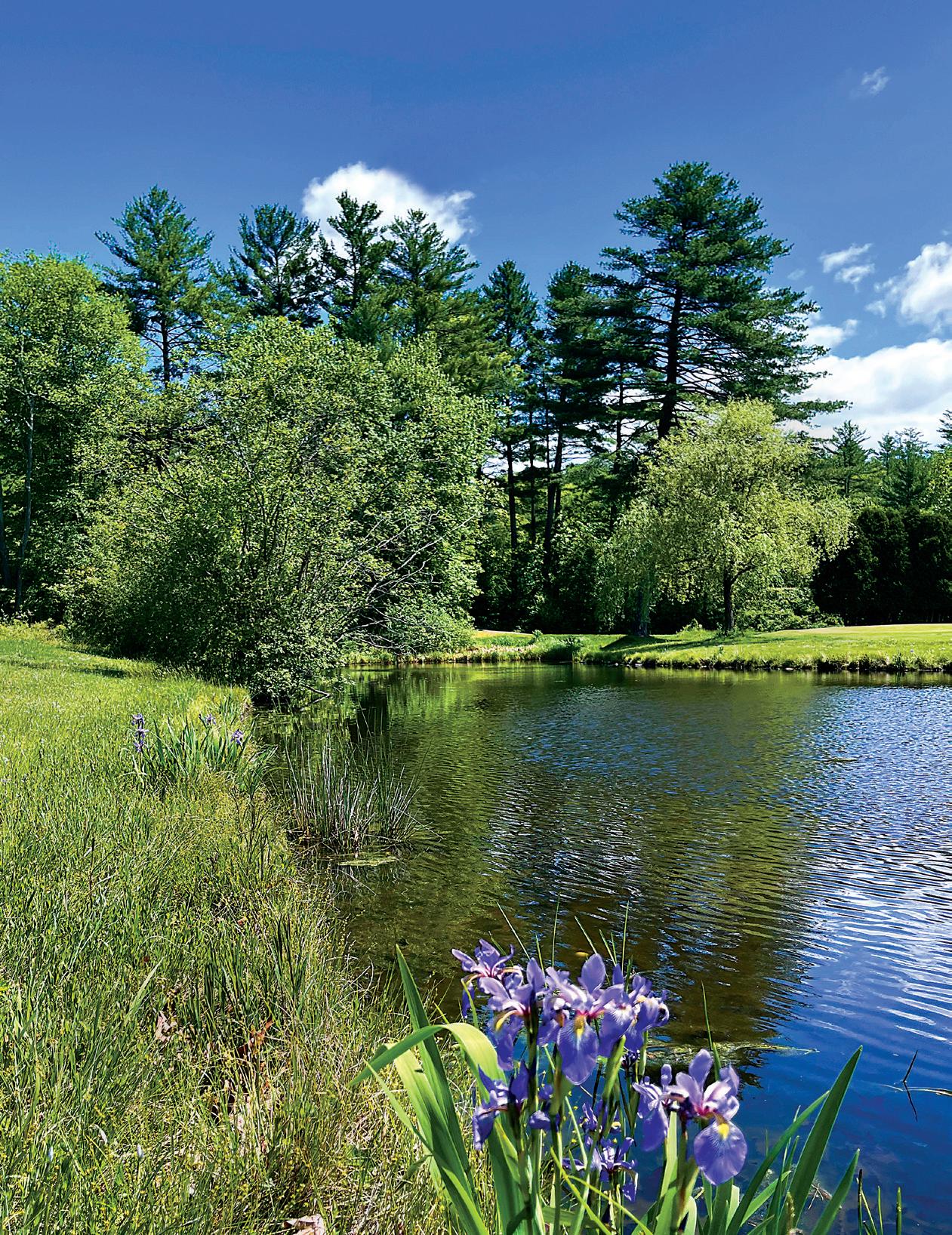

Charting a Bold Future
The
critical importance of land conservation

Announces New Specialty License

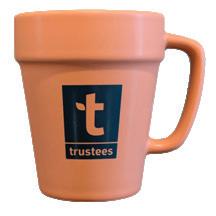
Summer Starts Here
Grab our new Trustees branded gear and hit the trails, beaches, and farms you love. Every purchase helps fund our mission to preserve exceptional places.
Shop our property stores or anytime at

The Trustees of Reservations Day in Massachusetts this May, the organization announced that a new Trustees specialty car license plate is available for pre-order. A portion of every initial plate purchase—and every two-year registration renewal—goes directly to The Trustees to support its mission of land conservation in the state. “We are always looking for creative ways to increase awareness and sustain our work to conserve and connect people to the outdoors,” said Katie Theoharides, President & CEO of The Trustees. “These new specialty license plates let Massachusetts residents visibly show their support for The Trustees and the proceeds will help fund conservation and protection of special places for everyone to enjoy.” Anyone with a passenger vehicle registered in Massachusetts is eligible to pre-order and display their support for The Trustees. An initial 3,000 orders are required before the RMV can begin manufacturing the plates. Hundreds of plates have already been purchased as of press time. Find the full TheTrustees.org/LicensePlate.

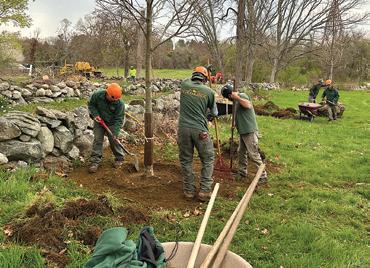
150 Arborists Volunteer at Millborn Farm for Arbor Day
The roar of chainsaws, woodchippers, trucks, and cranes pierced the still morning air around Millborn Farm in Sherborn this April. More than 150 members of the Massachusetts Arborists Association (MAA) donated their time on Arbor Day to both preserve and conserve one of The Trustees’ latest acquisitions. “According to MAA, it was the largest turnout of arborists for the annual day of service in the history of the organization,” said D.A. Hayden, Trustees Regional Vice President for the MetroWest. “Every volunteer arborist I spoke with was grateful for the opportunity to partner with The Trustees and spend time at Millborn Farm.” Teams removed dead and dangerous trees, pruned mature and historically significant trees, cleared hedgerows, preserved vistas, and planted new trees to be enjoyed for generations to come. While there is still a considerable amount of work to undertake before Millborn Farm opens to the public in summer 2026, the historic 195-acre farm is already strikingly improved thanks to the generosity of MAA’s members.
Increasing Resiliency on Nantucket
Over the past year, the Nantucket Conservation Foundation (NCF) and The Trustees have been working with GZA GeoEnvironmental to study coastal risk and resilience on The Trustees’ Coskata-Coatue Wildlife Refuge. Climate change and sea level rise are currently threatening to create a breach along the eastern shore of the refuge, allowing open water exchange between the Atlantic Ocean and Nantucket Harbor. NCF and The Trustees hope to use nature-based designs to increase habitat resilience, reduce flooding, and maintain the viability of this unique barrier beach system. GZA presented an alternatives analysis, along with preferred options for preserving this community treasure, at a virtual public meeting on May 27. Their presentation on findings and resilient designs for three critical locations—Coskata Pond, Coskata Woods trail, and the Haulover—were met with positive public feedback. GZA’s proposals largely include nature-based solutions to improve these areas and ensure that flooding and the potential for a breach by the Atlantic Ocean are kept to a minimum. To learn more about the project, visit CoskataCoatue.org.
Trustees Celebrates Pride
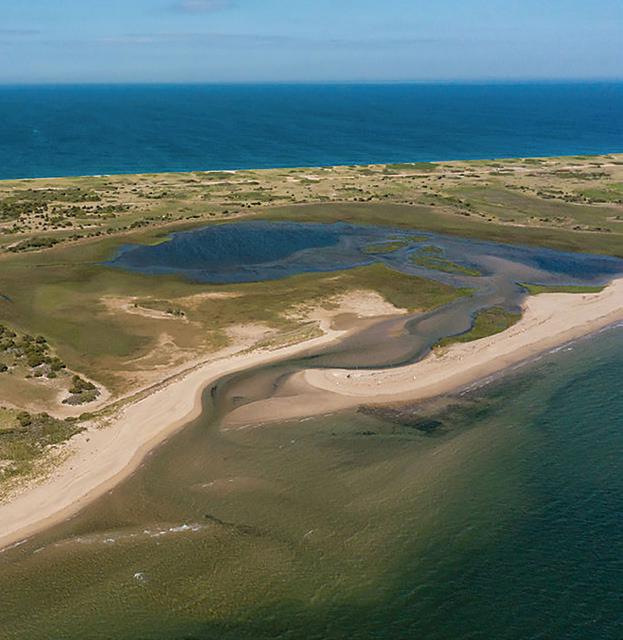
Pride was loudly celebrated across Trustees properties during June’s Pride Month, with signature events like the Naumkeag Tea Dance returning for a fourth year, to new lectures across North Shore properties shining a light on lesser-known stories of LGBTQ+ history. Lectures at Stevens-Coolidge House & Gardens in North Andover and Long Hill in Beverly covered R. Tripp Evans’ latest book, The Importance of Being Furnished: Four Bachelors at Home, and the queer language of flowers in partnership with The History Project, respectively. The Trustees LGBTQ+ Employee Resource Group (ERG), Trustees Pride, also made its 2nd-annual
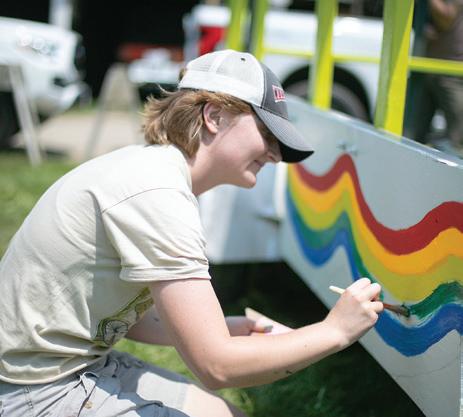
appearance at the Boston Pride for the People parade. The group and allies showed up in style, taking the idea of camp and running with it in every sense of the word—from summer camp to campy styles. The ERG’s float will also appear in this year’s Provincetown Carnival parade on August 21. Our LGBTQ+ friends and neighbors are valued, supported, and always welcome at every one of our special places throughout Massachusetts, every day of Pride Month and every day of the year. To learn more about Trustees LGBTQ+ pride events happening throughout 2025, visit TheTrustees.org/ Things-To-Do.
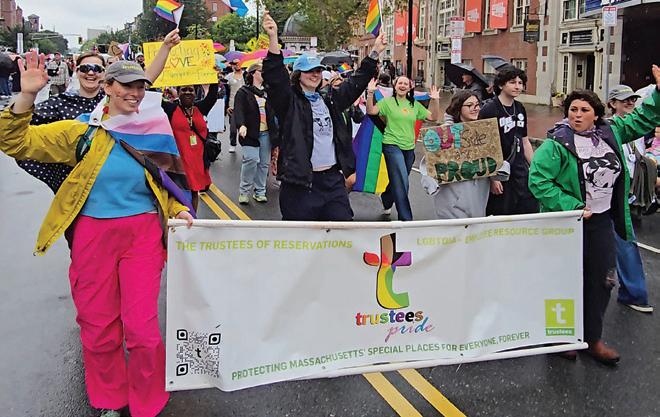
PHOTO BY ABOVE SUMMIT
OUT AND ABOUT
The Trustees MetroWest team came together in full force to represent The Old Manse during Concord250 on Saturday, April 19. Among those hosted were Massachusetts Governor Maura Healey (center, right) and Lieutenant Governor Kim Driscoll (center, left), along with General Gary M. Brito, Commanding General U.S. Army Training and Doctrine Command, Fort Eustis, VA (right) and other VIPs. The Manse played a proud and prominent role in the day’s celebrations, welcoming thousands of visitors and serving as a gathering point for distinguished guests ahead of the North Bridge Ceremony.
GBH Executive Arts Editor Jared Bowen was the honorary chair of deCordova's Party for the Sculpture Park in early May, helping an enthusiastic crowd celebrate the 75th Anniversary of the Sculpture Park and Museum's founding in 1950.
The Trustees was well-represented at the 35th annual Massachusetts Land Conservation Conference at UMass Amherst in March. Members of the Trustees Land Conservation staff presented workshops and other staff volunteers greeted conference attendees and highlighted our statewide work at our exhibitor's table.
Garden Coordinator (and Trustees 2023 Volunteer of the Year) Kory introduces new gardeners to Worcester Community Garden in Boston’s South End during a spring garden meeting.
The North Shore Education team hosted 300 8th graders on field trips recently as part of The Trustees’ continuing partnership with Salem Public Schools. Over the course of the day, students visited both Appleton Farms and the Crane Wildlife Refuge, observing and learning about pollinators, soil microbes, rotational grazing, coastal resilience in the salt marsh, invasive crabs, and much more.
Central Office staff celebrated Trustees Day on May 21, 2025— the 134th Anniversary of the founding of The Trustees by landscape architect Charles Eliot in 1891.
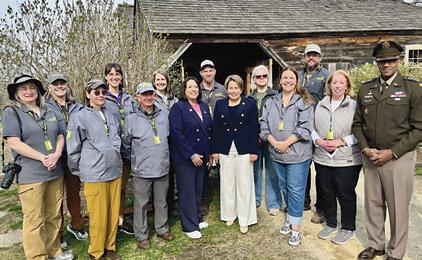
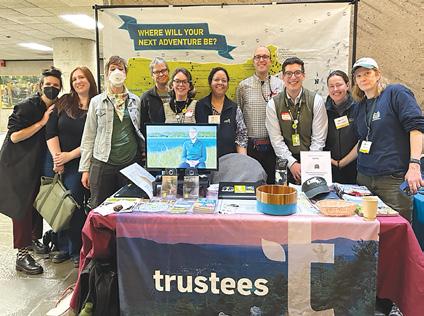
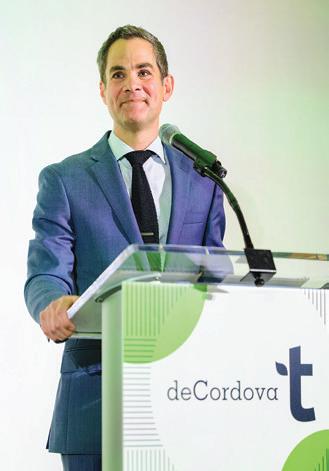
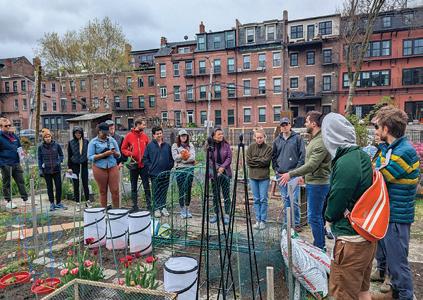
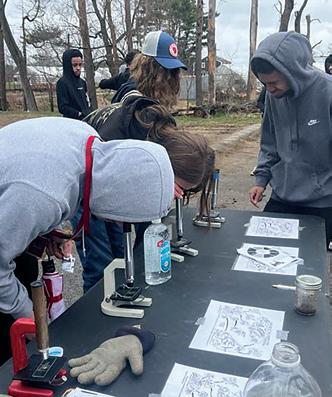
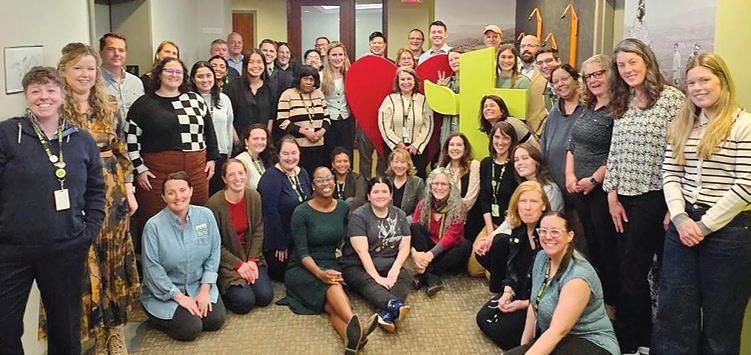
©KRISTA GUENIN
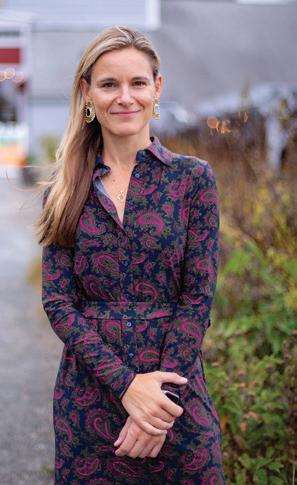
Happy summer,
As we enter this season, my thoughts turn to the words of Ralph Waldo Emerson, “Live in the sunshine, swim the sea, drink the wild air." The outdoors calls to us during these long sunlit days. We know how vital a connection with nature is, not just for summertime enjoyment and adventure, but for year-round physical and mental health.
Earlier this spring we got more involved with the Dirty Hands project. Created by Josh and Liz Moughan in memory of their nature-loving teenage son, Ty, the project leads a 200-mile hike along the Bay Circuit Trail each year to take action for mental health. The hike crosses through many Trustees special places, like Ward Reservation and Rocky Narrows, and for me it is a powerful reminder of the ability of nature to heal and to bring us together.
Right now, many of us are struggling with fear and uncertainty, as much of what we hold dear faces daily threats. We feel this in our conservation work with a barrage of new threats to environmental protection, public funding, and access to nature every day. In a moment when it is easy to despair, how do we find hope while tending to our own resilience?
At The Trustees, we’re prioritizing two things: collective action and moments of respite in nature. Together, these things restore hope and give us the energy to accelerate our work to protect special places for everyone, forever.
Collective action, like volunteering, growing native plants in your garden, protecting land, or participating in a protest or advocacy campaign can be powerful tools to build hope and combat despair. As we accelerate our conservation efforts over the next several years, we are focusing on solutions and bringing people together by connecting to nature.
When what you need most is a quiet moment to pause and breathe, I invite you to “drink the wild air” and join us at one of our special places. Hike a wooded trail, watch the sunrise from a beach, spread out a picnic blanket, or rest beneath a giant oak tree.
See you outside,
Katie Theoharides President and CEO
SAVING Special Places
Conserving land in the Commonwealth
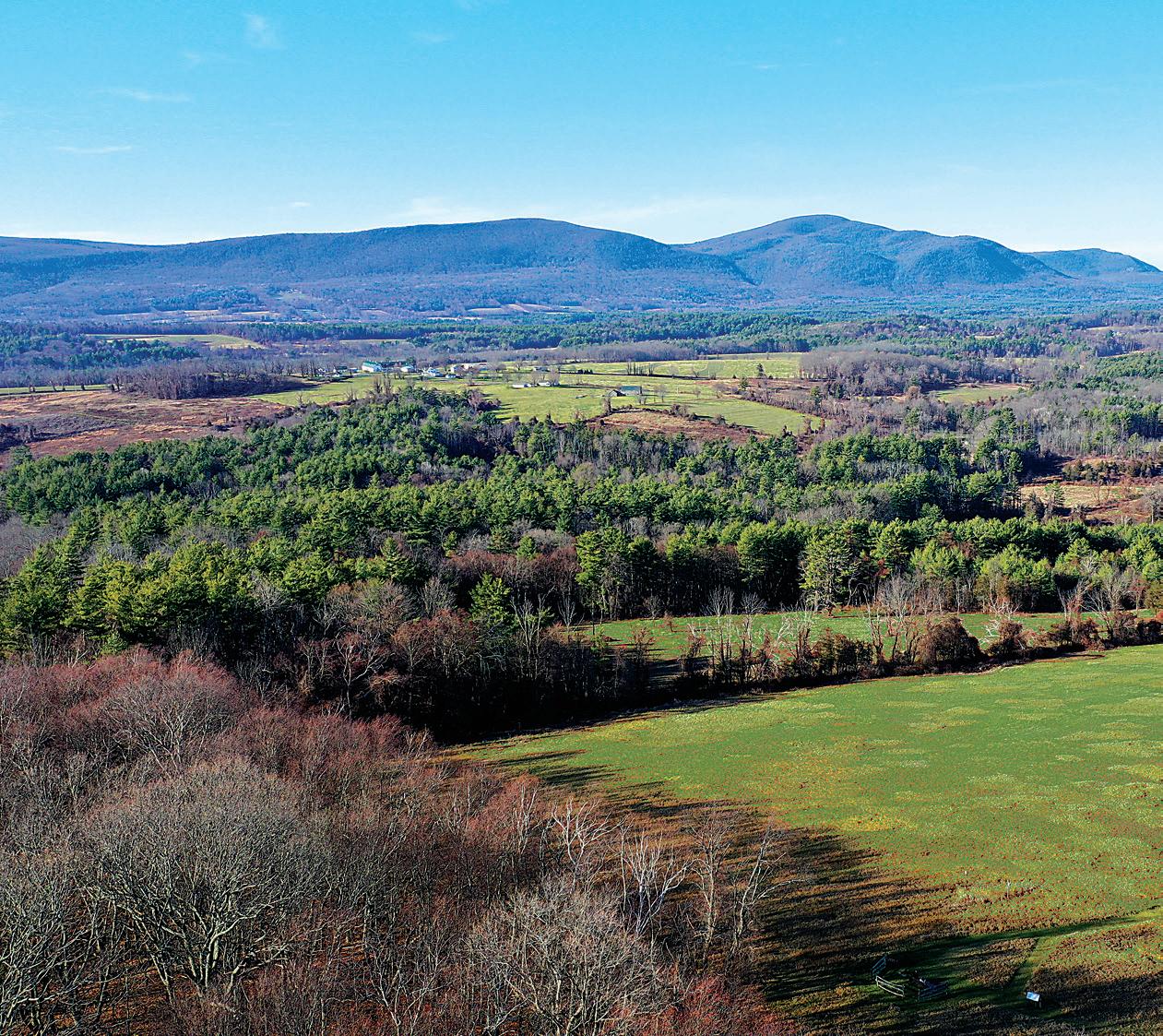
BY JOSEPHINE BRENNAN TRUSTEES STAFF
TThe centerpiece of the Trustees mission is protecting places of ecological, scenic, and historic importance for everyone, forever. At the center of the organization’s ability to reach that goal is its eight-person land conservation team.
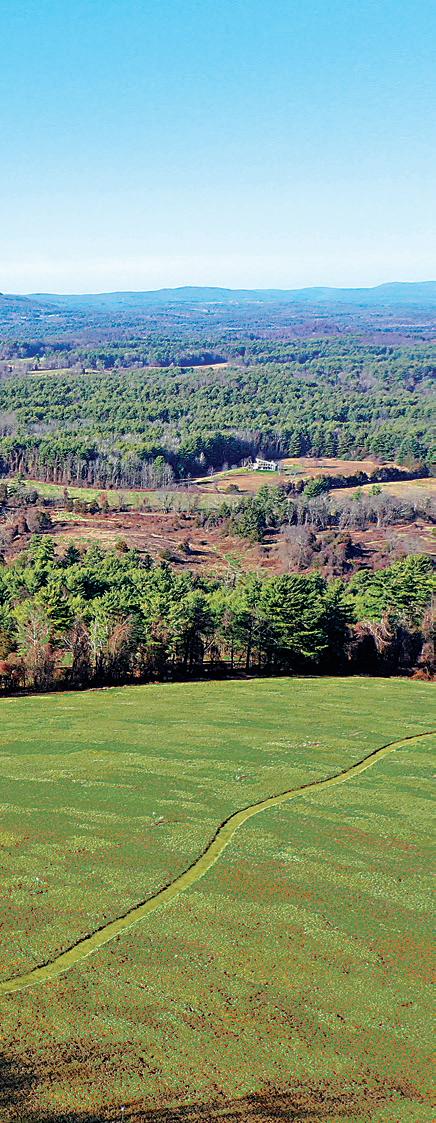
The Trustees' Land Conservation team searches for land across the Commonwealth that has significant cultural, agricultural, scenic, natural, and recreational ties. They develop relationships with landowners and partners within the community—embarking on, often years-long (and occasionally generationslong) journeys to bring conservation restrictions and new reservations under Trustees' stewardship and ownership—and with partner organizations in achieving conservation. “Land conservation is the forward-looking part of our mission,” shared Jennifer Dubois, Vice President of Land Conservation. And land conservation is tied to every aspect of the Trustees’ future work
WHY NOW?
In the organization’s new strategic plan (see Charting a Bold Future, page 18), The Trustees is embarking on an ambitious goal to accelerate conservation—increasing the average acreage protected annually, from approximately 300 acres to more than 2,000 acres.
“We have to move fast, be bold, and think bigger,” said Dubois. “We need to partner with other organizations, support their work, and be creative in finding conservation solutions that work for landowners and for communities.”
“Fast” because this comes at a time when a generational land transfer is occurring. An aging baby boomer population and an aging farmer population are looking at options for continued stewardship of their land. The real estate market and other economic factors are putting additional pressure on these landowners to make decisions about the future of their land.
“Now is also a time where more than ever people are disconnected from nature
and each other,” continued Dubois. “Conservation of open, scenic, wild, and agricultural lands is imperative to the health and wellbeing of individuals and communities.”
PEOPLE: THE CENTER OF IT ALL
The Trustees mission is focused on sharing conserved land and making it available for everyone, forever. Conserved land provides respite, a place for people to recreate, decompress, and connect with each other through nature.
“We want to conserve places that welcome all people and that provide meaningful opportunities to connect with nature and with each other. We are always looking to grow our relationships with the
The Trustees is embarking on an ambitious goal to accelerate conservation— increasing the average acreage protected annually to 2,000.
hundreds of communities throughout the state.” Dubois continued, “By providing these opportunities, people and communities have the chance to appreciate the importance of nature in their lives, and be inspired to take action themselves.”
Land conservation also supports the health and wellbeing of individuals and
A portion of the Cooper Hill Conservation Project in Sheffield, as seen from above Bartholomew's Cobble.
communities, whether they are accessing the land or enjoying the benefits from afar. Conserved land contributes to the protection of clean air and drinking water, and provides habitat for flora and fauna, among many other benefits that promote climate resilience.
WHAT WE’RE WORKING ON
A vast array of projects are in the Trustees’ conservation pipeline. Among the significant efforts that Members will soon be hearing more about are:
Cooper Hill Conservation Project
The Trustees recently partnered with nine other conservation organizations in Massachusetts and Connecticut to protect more than 1,000 acres surrounding Bartholomew’s Cobble in Sheffield in a project known as the Cooper Hill Conservation Project. This landscape-scale effort resulted in 160 acres acquired by The Trustees to be added to the Cobble, the 444-acre Pine Island Farm protected and sold to a new farmer, and two parcels of land acquired for conservation just over the border in Connecticut.
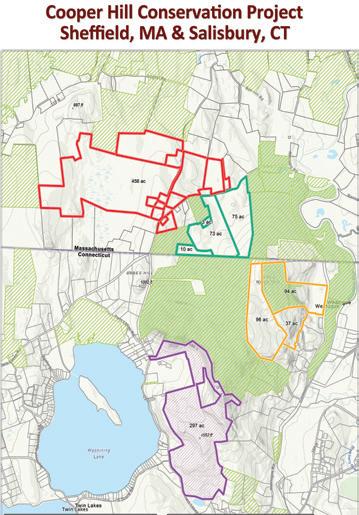
The Healey-Driscoll Administration dedicated more than $4 million in Agricultural Preservation Restriction (APR) funding for the conservation of Pine Island Farm, and a Landscape Partnership Grant through the Executive Office of Energy and
Environmental Affairs. “This project is a wonderful example of the way that we can work together with other organizations, including the state, in public-private partnerships to achieve greater impact,” said Dubois.
The Trustees continues to pursue more opportunities to create connected landscapes like Cooper Hill. These spaces create wildlife corridors, allowing for species migration due to climate change adaption, and create more resilient natural lands. “The Cooper Hill example is just one example,” said Dubois. “Together with our partners we have knit together this conservation of habitat, forestland, and farmland that is predominantly unfragmented.”
Westport Land Conservation Trust
The Trustees recently partnered with the Westport Land Conservation Trust (WLCT) to protect 142 acres adjacent to WLCT’s signature property, Westport Woods. The Trustees pre-acquired the property in 2024 to facilitate a public grant for WLCT and now holds a Conservation Restriction over this property, which WLCT will manage for passive recreation.
Rewilding Beaver Brook
At press time, The Trustees is finalizing the acquisition and conservation of the 250-acre Beaver Brook golf course and surrounding woodlands in Williamsburg and Northampton (see Spotlight, page 7) in partnership with Hilltown Land Trust. Beaver Brook will be the organization’s first golf course restoration project—plans include the restoration of the Beaver Brook watershed and activating trails for recreation.
Conservation Restrictions
Conservation Restrictions (CRs) are another tool to protect private land from development. A landowner, whether they are an individual, family, trust, nonprofit, etc., chooses to work with a qualified conservation organization—such as The Trustees—as holder, to create a stateapproved CR document specific to the property.
A CR protects conservation values and public benefits by prohibiting certain actions such as subdivision of the property and the
cutting of its trees, while permitting the landowner to retain specific other rights or actions such as managing hiking trails or growing crops on farmland, as well as the right to donate or sell the property in the future. Conservation Restrictions are permanently attached to the property.
The Trustees’ Land Conservation team is constantly pursuing more opportunities to help establish CRs across the Commonwealth. “It’s fascinating that we have protected more than 20,000 acres via CR in the 53 years since Conservation Restrictions began, yet it's taken 134 years to acquire the 27,000 acres that we steward and manage ourselves as reservations,” shared Dubois. “So, conservation restrictions are a complementary tool to the work that we do on our reservations.”
Despite their private nature, Conservation Restrictions are another land conservation tool that benefits people. “These restrictions can protect water and forests, all of which contributes to carbon sequestration,” said Dubois. “They can be created in larger blocks of open space nestled within land that is publicly accessible. Protecting land with conservation restrictions provides public benefits even when the public is not stepping foot on those parcels.”
THE FUTURE
Land conservation will drive The Trustees forward in years to come, as a critical strategic initiative that offers hope in the face of a changing climate. “I find hope in people. In the willingness of landowners to work with us, the collaborative nature of our nonprofit and government partners, the generosity of our supporters, Members, and donors, and the dedication of our team to do this work,” said Dubois.
“I want people to find hope in their experiences in nature. To go on a walk in the fall and feel the leaves crunching under your feet. To sit at the ocean's edge and feel the wind and hear the waves crashing. Biting into that fresh-picked strawberry, or visiting your local farm stand,” she continued. “I hope people have these experiences in our conserved spaces and see that they are a part of nature. That’s why we do this work.”
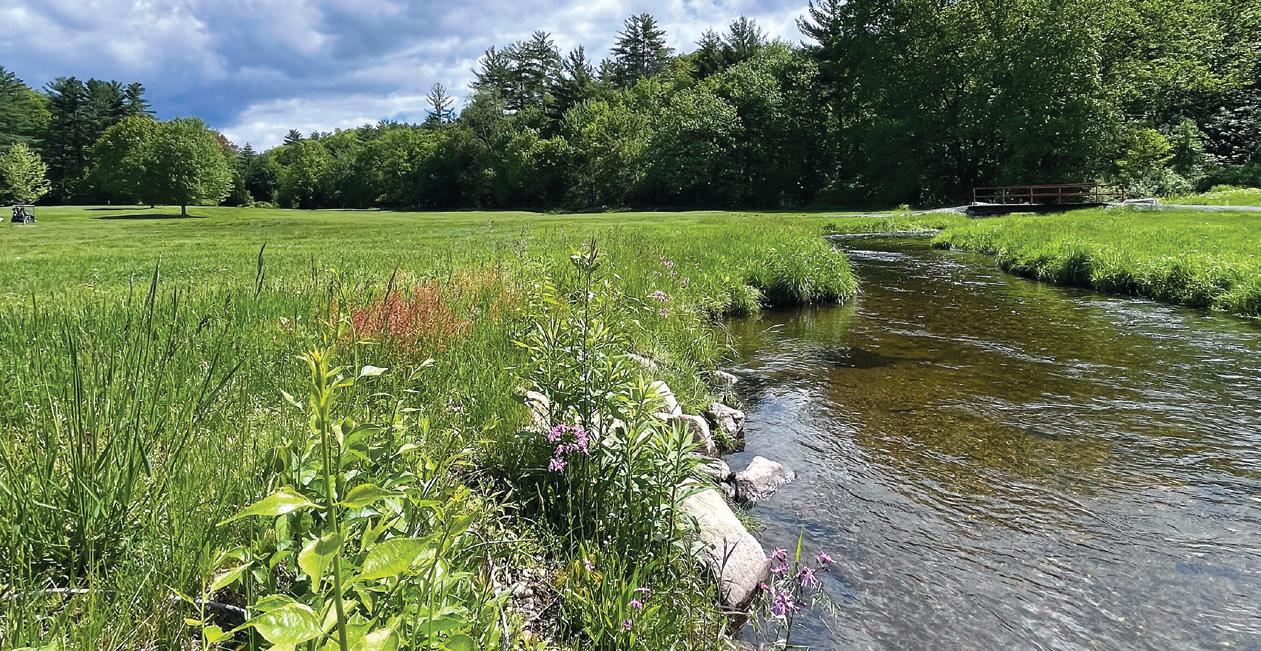
Restoring nature and connecting community
REWILD Beaver Brook
As this issue of Special Places goes to print, The Trustees—in partnership with the Hilltown Land Trust—is finalizing the purchase of 250 acres of floodplains, wetlands, and forests in Williamsburg and Northampton, and is beginning the transformation of the existing 9-hole golf course into a dynamic hub for conservation, community, and recreation. An intensive fundraising effort over the past four months has garnered the support of the community and a number of generous donors, including Members, supporters, and conservation partners.
“Protecting and restoring Beaver Brook, one of the largest remaining tracts of open land in the Northampton area, will provide new opportunities for people to get outside while enhancing critical wildlife habitat, and building climate resiliency,” said Katie Theoharides, president and CEO of The Trustees. “As an organization, The Trustees is committed to continued support for critical conservation work in Western Massachusetts and look forward to stewarding this important community resource.”
The Vision for Beaver Brook
As a Trustees property, the existing 9-hole golf course will be rewilded into a community park, offering accessible trails and scenic views. Replanting native species and regrowing floodplain habitats will allow
the brook to naturally meander and help mitigate flooding that occurs in nearby neighborhoods, enhancing biodiversity and climate resiliency of Beaver Brook. As climate change threatens biodiversity and leads to more frequent, heavy rainstorms, restoring and reconnecting this landscape will help strengthen its resilience.
Beaver Brook sits on Route 9 in Williamsburg, along a bus route and near a long-distance bike path, making it highly accessible from Northampton, Amherst, Easthampton, and Holyoke. The diverse trail network and cart paths, and connections to nearby conservation areas, provide potential for inclusive, accessible trails for walking, mountain biking, and cross-country skiing.
The property’s large timber frame pavilion will be an ideal location for community gatherings and educational programs, and existing amenities will ensure a welcoming experience for visitors.
Beaver Brook offers a rare combination of easy access to nature, active experiences, and the ability to be together in community. The Trustees looks forward to opening this property as a reservation in the very near future.
The campaign to fund the purchase and maintenance of Beaver Brook is ongoing. Your support is welcome! Visit TheTrustees.org/BeaverBrook for more information and to make a donation.

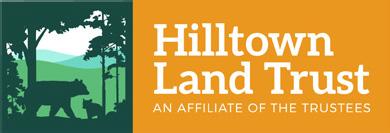
Hilltown Land Trust (HLT) works to conserve and steward land through strong relationships in order to ensure clean water, wildlife habitat, climate resilience, recreational opportunities, and healthy farmland for the benefit of all. After 24 years as an allvolunteer organization, Hilltown Land Trust affiliated with The Trustees in 2010, which provided HLT with significant infrastructural support, allowing it to focus on its core mission of land conservation and stewardship.
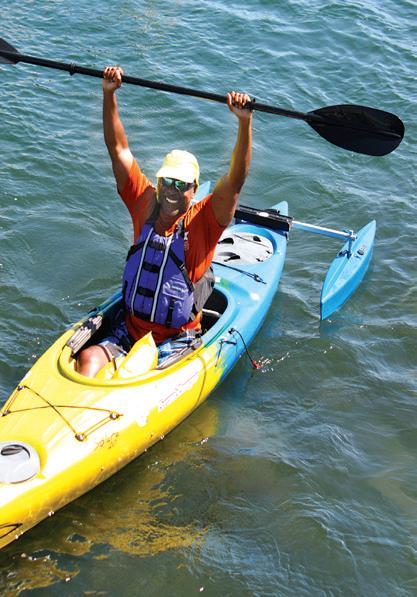
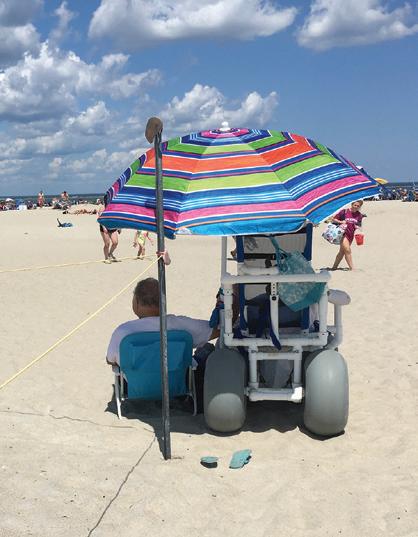
BY KYLE DAVI, TRUSTEES STAFF
At the heart of the Trustees mission is a powerful belief: the landscapes the organization protects are “for everyone.” But what does this promise mean when some special places are still out of reach for certain communities?
“We have been trying to reduce the barriers people face when accessing our properties—and nature in general—for quite some time,” says Kristen Swanberg, Managing Director of Education and Engagement for The Trustees. “But there’s a larger demand than what we can meet at the moment, so we’re looking to grow our work in this area.”
Various obstacles can get in the way of enjoying the outdoors, including physical barriers for people with disabilities, financial barriers for individuals with limited resources, and even age barriers for parents and guardians with younger children. All three of these gaps are currently being addressed by The Trustees but there is still more work to do.
We All Belong in
Removing barriers so everyone can access the outdoors
For Children & Parents
Finding engaging outdoors activities for younger kids often requires extensive planning, long travel times, or complicated logistics. Yet, being outside and interacting in a meaningful way with nature can be one of the most beneficial experiences in a child’s development.
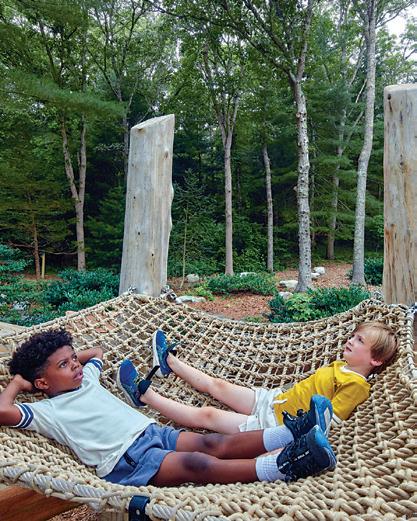
“Play spaces like the one at ArmstrongKelley Park on the Cape are so important,” says Swanberg. “Not only is it convenient for parents and guardians, but it provides a genuinely fun and enriching time for children.”
Made from fallen trees and other natural materials found on site at Armstrong-Kelley Park, the space is designed to appear big and wonderful to kids. They can climb a tangle of trees with a net hammock and rope ladder, balance on wooden steppers, cross a dried riverbed embedded with geodes, spot fossils pressed into stepping stones, and dash into a spiral fort with a boulder scramble.
It’s also designed with caregivers in mind. An accessible pathway curves through the area with ample benches to sit on that provide sightlines of the key play structures.
Each element is crafted with a wide age range in mind, so parents and guardians can sit back and feel confident letting their children explore on their own.
“The space meets children at the developmental age they’re at, offering a wide variety of ages access to nature on their own terms,” says Sara Brunelle, Studio Director at lu — la Studio, who designed ArmstrongKelley Park’s play space. “When that happens, an empathy for nature is created that persists for life… they essentially become future stewards of the land.”
To learn more and plan your visit to family friendly locations across the state, visit TheTrustees.org/FamilySpots.
For People with Disabilities
Time spent outside—whether it’s strolling through a park, sitting by the ocean, or soaking in a scenic view—can significantly improve an individual’s mental health. However, those with physical disabilities can face a multitude of challenges when trying to access these benefits not only due to inaccessibility of the natural terrain but a lack of adaptive resources too.
PHOTO COURTESY OF CREATING ABILITY
PHOTO BY JANE MESSINGER, COURTESY OF LU — LA STUDIO




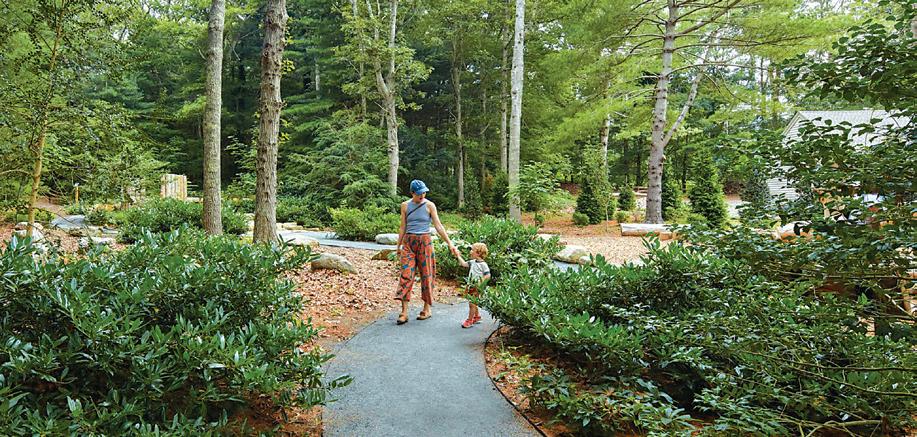
NATURE
“It’s not always feasible to build trails that meet universal accessibility requirements,” says Swanberg. “Instead, you can provide the adaptive equipment that allows people to fully enjoy the space that’s already there.”
One such piece of equipment is a fully accessible kayak, available for the first time this year at Long Point Wildlife Refuge thanks to support from the Martha’s Vineyard Community Foundation. Individuals with disabilities will now be able to safely enter the kayak and paddle on their own thanks to a transfer bench, adaptive paddle, stabilizing floats, and enhanced seating system designed by Creating Ability.
“With this new accessible kayaking equipment, we can improve the experience for many community members who historically have had limited access to the water due to physical disabilities,” says Molly Peach Mayhew, Islands Education Manager for The Trustees. “I'm excited to utilize this equipment with our community partners, residents, and visitors through our educational and rental programs at Long Point this summer.”
Various other accessibility equipment items are available at several different Trustees sites. The all-terrain GRIT Freedom Chair is now permanently available at World’s End in Hingham after a pilot program last year. Plus, a new swimming beach wheelchair has been added to Wasque on Chappaquiddick Island this summer—thanks to funding from Slough





Farm Fund—to accompany the waterproof beach wheelchairs that have been available at both Long Point on the Vineyard and Crane Beach in Ipswich for years.
“We’re always looking for new ways to allow everyone access to our natural spaces, and adaptive equipment has proven to be a great solution to overcome barriers,” says Swanberg.
To learn more about accessibility at The Trustees, visit TheTrustees.org/ Accessibility.
For the Cost-Conscious
While more than 100 Trustees special places across the state are open to the public for free, a few locations have admission or parking fees. Programming such as guided hikes, workshops, and seasonal celebrations may also require a ticket purchase to participate. These costs can hinder individuals with limited resources from enjoying many of the most popular Trustees locations and events.
“Not everyone can afford to visit these places and take in their beauty, history, and fun activities,” says Swanberg. "That's why we partner with government assistance programs, community groups, nonprofits, libraries, colleges, and universities to directly address such hurdles.”
Three programs—Cards to Culture, GO (Get Outside) Passes, and the Wonderfund Access Card—grant free or reduced admission for at least two adults and two children under 18 to many Trustees
locations. Cards to Culture is specifically for Massachusetts residents who receive EBT, SNAP, WIC, or ConnectorCare benefits, while the Wonderfund Access Card is available to Department of Children & Families (DCF) foster families. However, GO Passes can be checked out by any community member from the many participating libraries, colleges, and universities throughout the Commonwealth.
Recently, The Trustees also partnered with community groups to distribute complimentary tickets to seasonal events— like Halloween on the Hill in October at Long Hill in Beverly and Winterlights in December at Naumkeag in Stockbridge and the Eleanor Cabot Bradley Estate in Canton—to local residents who otherwise may not be able to afford to attend.
“This initiative lowers economic barriers and allows more people to experience the joy and beauty of the seasons at our properties,” says Lynn Murray, Director of DBIE Programs & Partnerships for The Trustees.
To learn more about all free and reduced admission opportunities, visit TheTrustees.org/DiscountAdmissions
The Trustees is continually seeking new and creative ways to break down the barriers— of any kind—that limit access to the outdoors. The organization is fully and deeply committed to its promise of making these special places “for everyone.”

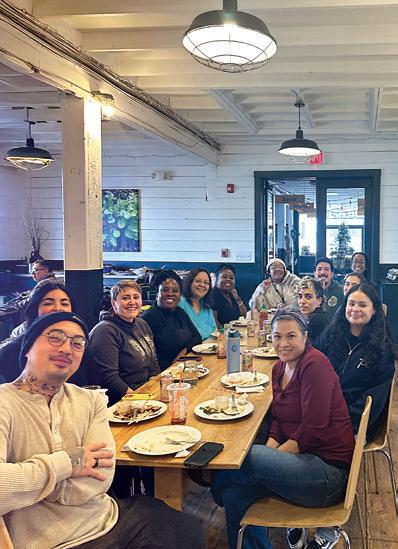
Centering BIPOC Leadership at The Trustees
BY LYNN MURRAY, TRUSTEES STAFF
AAt The Trustees, Employee Resource Groups (ERGs) are employee-led spaces formed around shared identities or interests. They are open to all staff, whether they identify with the group or participate as allies. ERGs offer connection, support, and opportunities for professional growth.
Conservation in Color (CiC) is one of our ERGs, created to support BIPOC (Black, Indigenous, and People of Color) employees. It offers a space to share experiences, celebrate identity, and build supportive relationships. CiC also brings forward perspectives that help influence organizational culture, programming, and strengthen our work.
Creating Connection
One of CiC’s newest ideas is Trustees in Color, an emerging initiative to help more communities of color connect with Trustees properties. These visits are envisioned as collaborations between CiC members and property teams and are designed to be welcoming, inclusive, and grounded in lived experience.
Internally, CiC is presenting a Speaker Series for Trustees staff members, to elevate the voices and expertise of BIPOC professionals and programming across conservation and related fields. These conversations invite all staff to learn from leaders whose perspectives are often underrepresented in environmental spaces. CiC is also focused on improving the experience of BIPOC staff through
professional development opportunities, and pathways for leadership. The group continues to grow, drawing new members and expanding its reach across the organization.
At its core, CiC is about belonging and making sure that BIPOC staff feel empowered, valued, and included within the broader mission of The Trustees. The group serves as a platform to uplift and amplify BIPOC voices, while fostering community and mutual support across roles and teams. Through connection, reflection, and collaboration, CiC celebrates both shared identity and diverse lived experiences. In doing so, it helps ensure that all staff can see themselves in the work of conservation and in the future we’re building together.

Last June, in the first Trustees in Color property tour, 5th and 6th Graders from the Haley School in Roslindale had a blast at Weir River Farm in Hingham.
CiC's January 2025 community-building meeting at Powisset Farm in Dover.
CiC members participate in a cooking workshop led by Chef Thi (left) at Powisset Farm.
True to Our Roots
The benefits of gardening with native plants
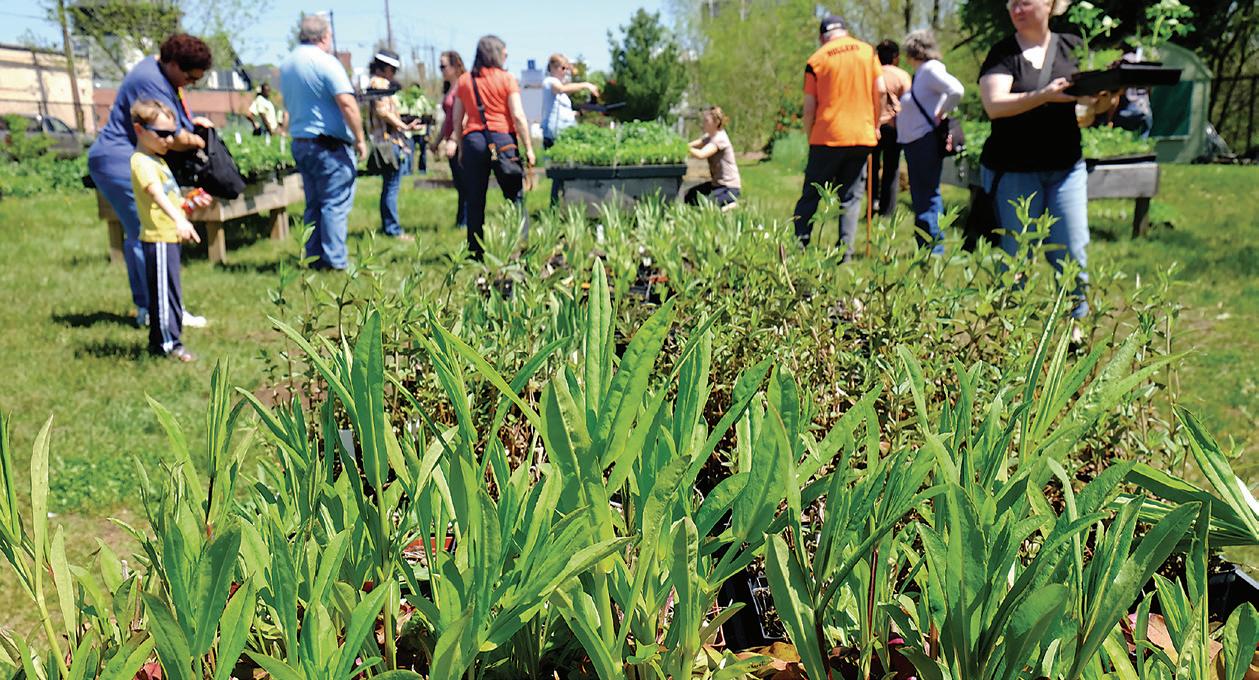
BY BETH MOORE, TRUSTEES STAFF
If you visit Allen C. Haskell Public Gardens in New Bedford this summer, you might find yourself wandering with fellow visitors through a blooming meadow of native coastal wildflowers. At Naumkeag in the Berkshires and at The Trustees’ Boston Community Gardens, too, visitors can enjoy native pollinator gardens and flowering trees alongside the gardens’ more traditional offerings.
As native plants take root at Trustees properties, visitors and gardeners are finding inspiration, tranquility, and connection in these shared special spaces. “Our approach is about finding a thoughtful balance,” says Kristin McCullin, Horticulturist at Haskell Public Gardens, “creating spaces that are both environmentally responsible and deeply enjoyable for all who visit.”
This approach has attracted human and non-human visitors alike to Trustees gardens in recent years. As we might visit a native plant garden to enjoy a walking meditation or attend a quiet gathering, local wildlife also frequent these spaces for their ecological benefits—including their reduced need for watering, fertilizers, and other human interventions. A native plant garden provides a unique dynamic space in which nature and culture can blend in a balanced way, fostering opportunities for
our own thoughtful caretaking of place and of one another.
Given this, native plant gardening is a perfect complement to The Trustees’ ongoing work of implementing more nature-based solutions to address climate change, create space for nature and wildlife in urban settings, and steward places thoughtfully into the future. “These properties are meant to endure for generations,” says Kristin. “It’s a beautiful balance of science and art.”
How to Get Growing
Growing native plants at home can begin with the simple act of paying attention. While wandering local verges, woods, and public gardens, “notice what catches your eye, take photos, and start building a sense of the shapes, textures, and plant combinations you’re drawn to,” Kristin suggests. “Nature is often the best designer.”
Aspiring growers should also consider the make-up of their available gardening spaces prior to planting. While native plants tend to be more resilient in any given space than invasive species, a sun-loving variety that grows well in a rooftop container garden may not thrive as well in a shaded backyard plot. A successful garden often combines personal preferences with local
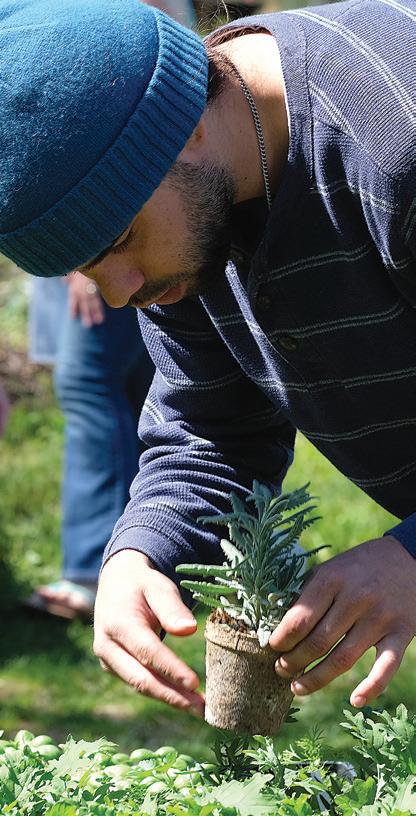
Ways to Grow and Share the Joy
Explore Trustees native plant gardens at our Boston Community Gardens, Haskell Public Gardens (New Bedford), Naumkeag (Stockbridge), or World’s End (Hingham; native garden coming soon!) for inspiration.
Visit City Natives in Mattapan for starter plants and advice. Stop by for an annual plant sale in spring and fall (the best times for planting), or by appointment throughout the summer.
Connect with fellow gardeners and share your expertise at Boston Community Gardens’ annual Gardeners’ Gathering.
For further information and details, visit TheTrustees.org
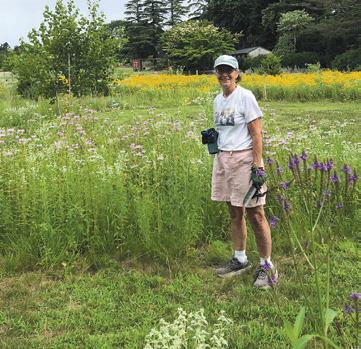
features such as light, moisture, and soil composition.
Once a gardener has considered these factors, involving others in the project can be especially helpful. While growing native plants directly from seed provides a more hands-on approach, growers should also feel free to approach nursery staff—such as those at The Trustees’ own City Natives in the Boston neighborhood of Mattapan, where more than 200 species of native plants are available—for first-time planting suggestions and advice.
"Nursery staff are often incredibly knowledgeable and generous with their time,” says Kristin. “They’re wonderful resources for helping you find plants that are suited to your specific conditions.” By providing nursery staff with a full picture first, growers can help set the stage for a thriving garden.
Then, with plants in hand and an open mind, it's time to jump into the work—to learn by doing. “No amount of books,
courses, or internet searching will replace hands-in-the-dirt gardening,” Stephen Zelno, Horticulturist at Naumkeag, advises. “You will learn the most by working in your own garden.”
Ultimately, the key to maintaining a sustainable native plant garden is flexibility—an openness to one's own shifting sense of place and creativity. “Start small,” says Kristin, “be observant, and let your garden evolve.”
Sharing the Joy of the Work
For many gardeners, the joy of growing native plants is two-fold: not only are the plants beautiful and sustainable, but they create moments of connection for all who encounter and tend to them. This joy is rooted in a shared practice of caretaking— of kneeling down and using one’s hands to benefit oneself and others.
“What I especially enjoy is watching visitors experience the garden,” says Kristin, “often unaware of the attention, time, and love that goes into creating such a serene and beautiful space.”
Growing native plants is also an opportunity to connect more deeply to place and surrounding wildlife, as Lacey Berg, Urban Grower at City Natives, notes: “Planting, weeding, watering, pruning, paying attention. It’s how I communicate to the plants (and the land, and all the other creatures) that I care about them.”
Finally, it is an ongoing commitment to learning—to growth within one’s given space and community. “No two days are the same,” says Kristin, “but that’s what makes the work so rewarding.”
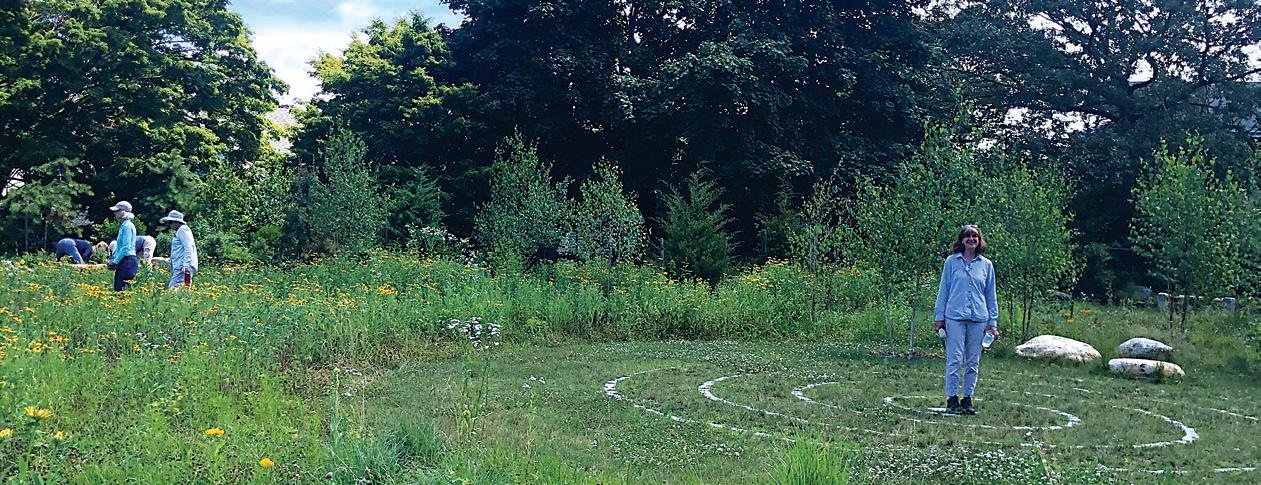
“ What I especially enjoy is watching visitors experience the garden, often unaware of the attention, time, and love that goes into creating such a serene and beautiful space.”
—Kristin McCullin, Horticulturist at Allen C. Haskell Public Gardens
Volunteers Wendy Forbush (above) and Massachusetts Master Gardener Nancy Flint (below, right), help tend to the native gardens at the Allen C. Haskell Public Gardens in New Bedford.
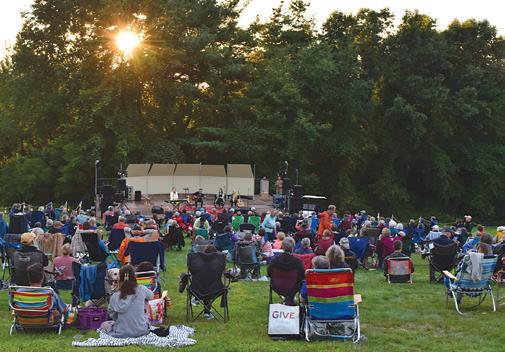
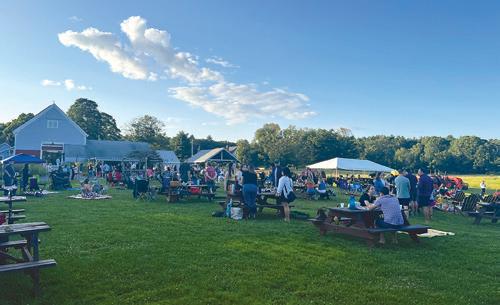
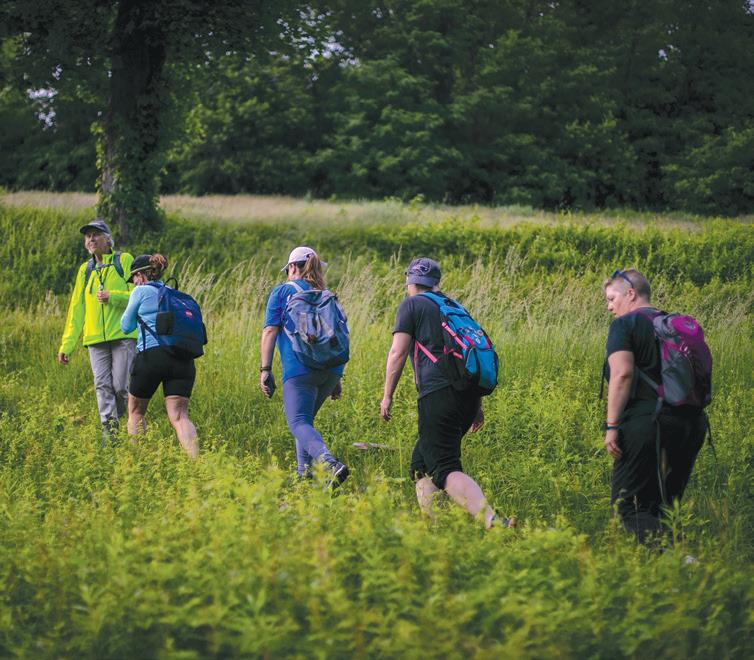
A summer to remember
Whatever your summer inspiration, there’s something for everyone at Trustees reservations this summer. From outdoor concerts and picnics with some of the best views in Massachusetts to house tours at places with deep ties to our nation’s history, to recreational options like hiking, kayaking, and more—give us a try and we’ll help make this a summer to remember!
COME HEAR THE MUSIC
Our hills are alive with the sound of… well, you know, music! Favorites like the Castle Hill Picnic Concerts (Ipswich) present shows featuring Cuban-infused R&B-Rock-Reggae to Classic Rock, Soul & Motown to Big Band Swing. Fruitlands Museum’s Summer
Concerts include perennial favorites, the Concord Band, along with the James Montgomery Band, Roomful of Blues, The Love Dogs, and more. The deCordova Performance Series (Lincoln) features the likes of Girl Power Playlist Live, Leslie Mendelson, and Low Lily Band. Scenic Songs, the unique Trustees unplugged live music experience, is back with Matt the Electrician, Erin McKeown, and Natalia Zuckerman at Notchview in Windsor and Mark Erelli and Dinty Child at World’s End in Hingham.
There’s music and more at our Sunset Picnics at Weir River Farm in Hingham and our Summer Sunsets at Powisset Farm in Dover. Feel the summer breeze as you sip on a cool beverage, enjoy farm-fresh food, and take in the last rays of the day’s sun in the great outdoors. It’s summer at its finest!
THERE ARE SO MANY TRUSTEES THINGS TO DO THIS SEASON!
OUTDOOR ADVENTURES
Take a Full Moon Hike at World’s End, the Crane Estate, and Lyman Reserve (Buzzards Bay), or through Trustees partner Adventure East at Notchview or Peaked Mountain (Monson). Go kayaking with CraneOutdoors for a uniquely memorable adventure on Fox Creek and around Choate Island and the Crane Wildlife Refuge in Ipswich & Essex. Venture out on a Waterfall Hike with Adventure East, from Bullitt Reservation to Chapel Brook in Ashfield. Or, for an adventure of the soul, try Mindfulness Meditation or Sunset Yoga at Naumkeag in Stockbridge, Art of Presence Yoga at deCordova, or our Full Moon Yoga Series at Chilcott & Granada Community Garden in Jamaica Plain.
Summer 2025 Highlights & Special Events
A glimpse at just a few of the hundreds of things to do at our special places across the state this season. For a list of upcoming programs curated just for Trustees Members, including registration and ticketing information, visit TheTrustees.org/CuratedEvents. We hope to see you at one of our reservations soon!
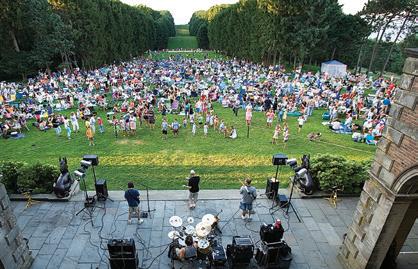
Picnic on the Farms
Come Hear the Music!
From large picnic-style concerts to smaller intimate performances, find your perfect blend of live music and stunning scenery. Visit TheTrustees.org/Concerts for schedule details and tickets.
Castle Hill Picnic Concerts, Ipswich; deCordova Performance Series, Lincoln; Fruitlands Summer Concerts, Harvard; Rocky Woods, Medfield; World’s End, Hingham
Spectacular views and sunsets make our farm picnics unforgettable. Feel the summer breeze as you sip on a cool beverage, have a bite of local deliciousness, and enjoy live local music. It’s summer at its finest!
THURSDAYS, JUL 24 & AUG 21
Summer Sunsets at Powisset Farm, Dover
THURSDAYS, JUL 17 & 31, AUG 28
Sunset Picnics at Weir River Farm, Hingham
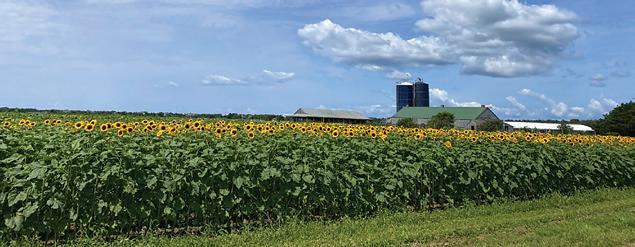
Scenic Songs
Calling all outdoor enthusiasts and music lovers! Join us in scenic locations with some of your favorite performing artists for special, unplugged live music experiences like no other. These acoustic shows are unique opportunities to enjoy live music in community and nature. TheTrustees.org/ScenicSongs
SUNDAY, JUL 13: MATT THE ELECTRICIAN, ERIN MCKEOWN, AND NATALIA ZUKERMAN
Notchview, Windsor
SATURDAY, SEP 13: MARK ERELLI AND DINTY CHILD World’s End, Hingham
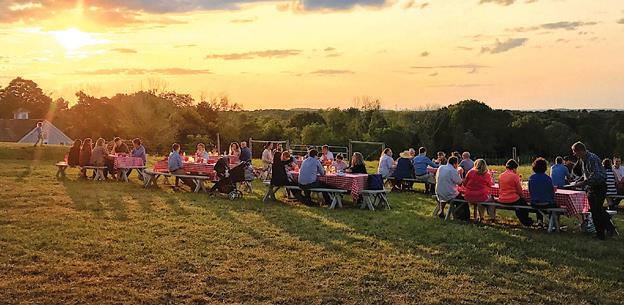
On the Vineyard: The FARM Institute
Celebrate 25 years of The FARM Institute with a full schedule of programs each week, all summer long. Come enjoy cooking classes, ice cream making, pick-your-own sunflowers, wagon rides, barnyard visits, and more! TheTrustees.org/TFI-Programs
The FARM Institute, Edgartown
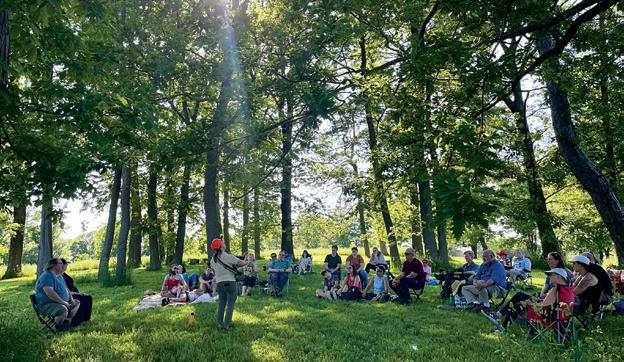
For a FULL LISTING OF PROGRAMS not shown here, visit TheTrustees.org/Things-To-Do
Program details subject to change. For up-to-date event information, or to search for events in your area, at a
click on Things To Do at TheTrustees.org
property, by
or by
©TRUSTEES
PHOTO BY TOM KATES

Roaring Twenties Lawn Party
It’s the party of the summer! This popular two-day event features 1920s & 30s jazz on two stages, flappers and dandies, antique autos, lawn games, dancing, contests, a vintage fair, and more. Details at RoaringTwentiesLawnParty.org
SATURDAY & SUNDAY, AUG 2 & 3
Elizabeth Freeman Day Celebration
Join us for celebrations and house tours honoring the legacy of Elizabeth Freeman, who was enslaved at the Ashley House before she boldly sued for her freedom and helped end slavery in Massachusetts. TheTrustees.org/ Ashley-House
SATURDAY, AUG 23
Ashley House, Sheffield
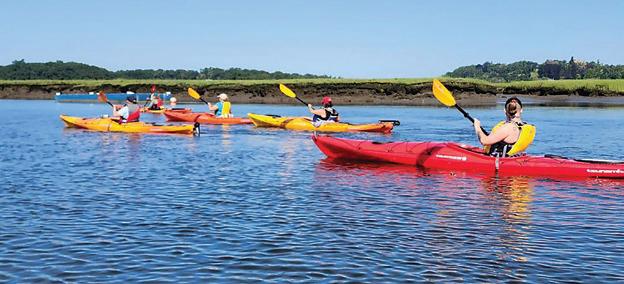
Summer BloomFest
THURSDAY-SUNDAY, AUG 7-10
Stevens-Coolidge House & Gardens, North Andover
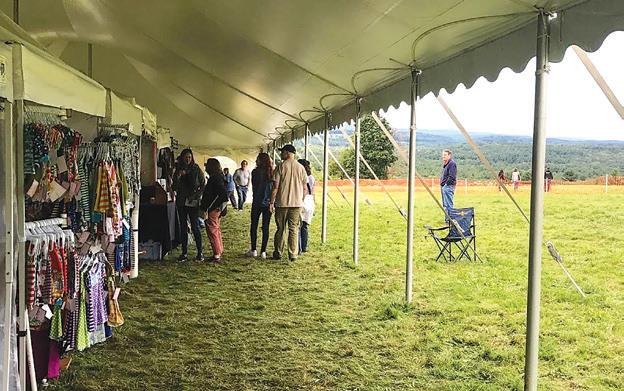
Castle Hill on the Crane Estate, Ipswich ©TRUSTEES
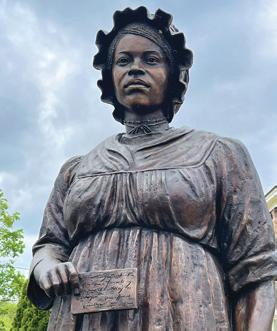
CraneOutdoors Kayak Adventures
Kayaking season at the Crane Estate runs through mid-October. Enjoy a broad portfolio of professionally guided adventures, including the fan-favorite Choate Island Kayak & Hike trip, historic Fox Creek paddle, and memory-making sunset paddle. Details at TheTrustees.org/CraneOutdoors
The Crane Estate, Ipswich & Essex
Stroll through the gardens in peak bloom, bursting with vibrant color and fragrance. Enjoy daily garden tours, self-guided house tours, interactive programs and workshops for all ages, and more!
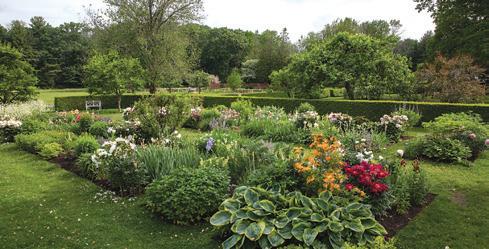
13th Annual Craft Festival at Fruitlands Museum
Fruitlands’ picturesque grounds come alive with artisans from all over New England. Top quality craft, museum offerings, and stunning views make this festival an ever-popular destination— the perfect fall outing to find holiday gifts for family and friends. Details at TheTrustees.org/CraftFestival
SATURDAY & SUNDAY, SEP 20 & 21
Fruitlands Museum, Harvard
©TRUSTEES
PHOTO BY COCO MCCABE
©TRUSTEES ©TRUSTEES
ART & EXHIBITIONS
EXHIBITIONS ON VIEW
For more information on these and all Trustees exhibitions, visit TheTrustees.org/ Exhibitions
FRUITLANDS MUSEUM
102 Prospect Hill Road, Harvard
“A GOOD MANY HANDS” SHAKER COMMUNITIES
WOVEN THROUGH WORD, IMAGE & OBJECT
Through November 2, 2025
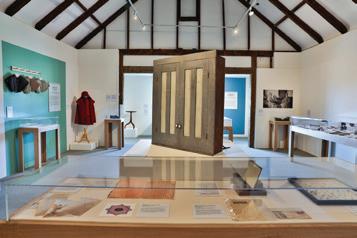
Celebrating the Shakers—an influential religious movement—and their vibrant community and beliefs during the 250th Anniversary of their arrival in America, this exhibit features never-before-seen journals, letters, photographs, furniture, and objects from the Fruitlands Museum collection. Plus, artist Brece Honeycutt opens a contemporary art installation incorporating a kaleidoscope of Shaker color in the historic Shaker Office.
ACROSS BOUNDARIES
ACROSS BARRIERS
Ongoing
New works of art from several Native American communities refresh this year’s exhibit grounded in Indigenous ways of knowing and the living presence of Tribal Nations. Concepts of the personal body, seasons, colors, and times of day (among others) are explored using directional framework derived from the symbol of a medicine wheel.
PLACE OF INTERSECTION: SURVIVANCE IN THE AMERICAN WEST
Through May 5, 2026
A variety of new objects on display reinvigorate the discussion between the stereotypical “still lives” of what the West was like when it was “won” in the 19th & 20th centuries and what the cultural landscape was actually like for the Native communities who lived it.
DECORDOVA SCULPTURE PARK AND MUSEUM
51 Sandy Pond Road, Lincoln
NATURE SANCTUARY
Through October 4, 2026
Six women artists explore the creative relationships between the natural world and ideas of home in this new outdoor exhibit. Together they link deCordova’s ecology, its past as a family home, and its integration with The Trustees in a landscape shared and shaped by people and art.
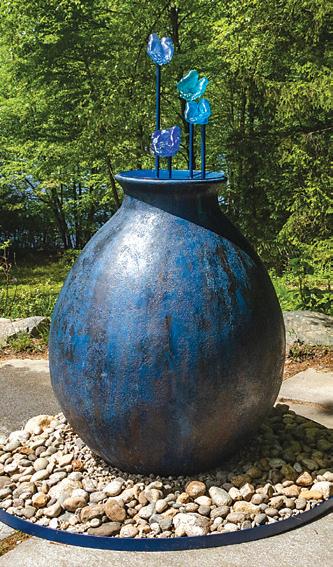
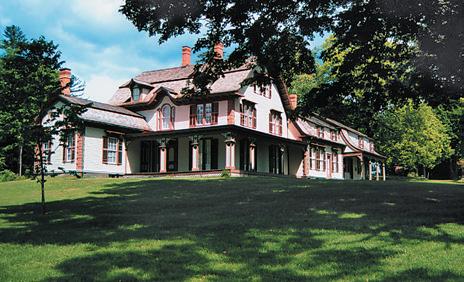
HISTORIC SPACES
For schedule details and to register for tours, visit TheTrustees.org/HistoricSpaces
ASHLEY HOUSE
Sheffield
Uncover a deeper, more inclusive understanding of liberty, justice, and individual courage at the Elizabeth Freeman exhibit.
THE GREAT HOUSE AT CASTLE HILL
Ipswich
Weekend tours explore the people, pets, architecture, and famous movie sets of the Crane Estate.
LONG HILL
Beverly
Dive into the rich history of this grand country estate with a 10:30AM tour on Saturdays and Sundays (through September 21).
THE MISSION HOUSE
Stockbridge
Guided tours return on select Fridays and Saturdays throughout the summer sharing the interesting history of the Mohicans and the area’s first minister.
NAUMKEAG
Stockbridge
Discover the secrets of running a Gilded Age country estate during a Backstairs Tour Thursdays–Sundays at 9:30AM (through August).
THE OLD MANSE
Concord
Hourly guided tours on weekends from 11AM–4PM uncover the hidden stories of this National Historic Landmark.
STEVENS-COOLIDGE HOUSE & GARDENS
North Andover
Enjoy an in-depth look at the historic home with an 11AM weekend tour (through September 28).
WILLIAM CULLEN BRYANT HOMESTEAD
Cummington
Step into the beloved family home of this 19th-century poet, journalist, and conservationist. Open on select days this summer!
WILLIAM CULLEN BRYANT HOMESTEAD CUMMINGTON
PHOTO BY M. ARDUSER
PHOTO BY KATE WOOL
Evelyn Rydz, Holding Water, 2025. Cast glass, steel, concrete, field stones. Courtesy of the artist. Photo by Rafael Medina.
HISTORY COMES ALIVE
The Trustees cares for a dozen historic homes across Massachusetts, with histories that span more than 300 years. Take in one or more of our engaging tours this summer—from the new The Revolutions of The Ashley House in Sheffield to the infamous Attic Tours at The Old Manse in Concord, beloved Guest of the Cranes and Behind the Scenes in the Great House tours at Castle Hill in Ipswich to the Backstairs Tours at Naumkeag and Mohicans, Missionaries, and Migrating Colonists at The Mission House in Stockbridge, and much more. New this summer, head to Cummington, where the William Cullen Bryant Homestead will be reopened on select days for Literary Legacy: A Guided Tour!
WE’RE HERE TO HELP
Trustees has your weekend inspiration in mind! Look for our Things To Do

This Weekend page at TheTrustees.org/ Weekend where you’ll find detailed listings of everything happening at Trustees properties, with links for signing up. Weekends need to be easy and Things To Do This Weekend is here to help! Also, check out our Events Curated for Members page at TheTrustees.org/ CuratedEvents for a selection of events and programs that should be of special interest. There you’ll also find links to our downloadable six-week listings calendars.
HOLIDAY MAGIC RETURNS WITH
These are updated every month, so you’ll always be able to find out what’s happening soon at a reservation near you. Bookmark the page and you’ll never miss a program or event—there’s never a dull moment at Trustees reservations!
As always, schedules are subject to change, so please be sure to check TheTrustees.org/Things-To-Do for the latest program information and to use your Member discount when you sign up.

NAUMKEAG STOCKBRIDGE
PHOTO BY DAVID EDGECOMB
The Trustees looks ahead to the next five years
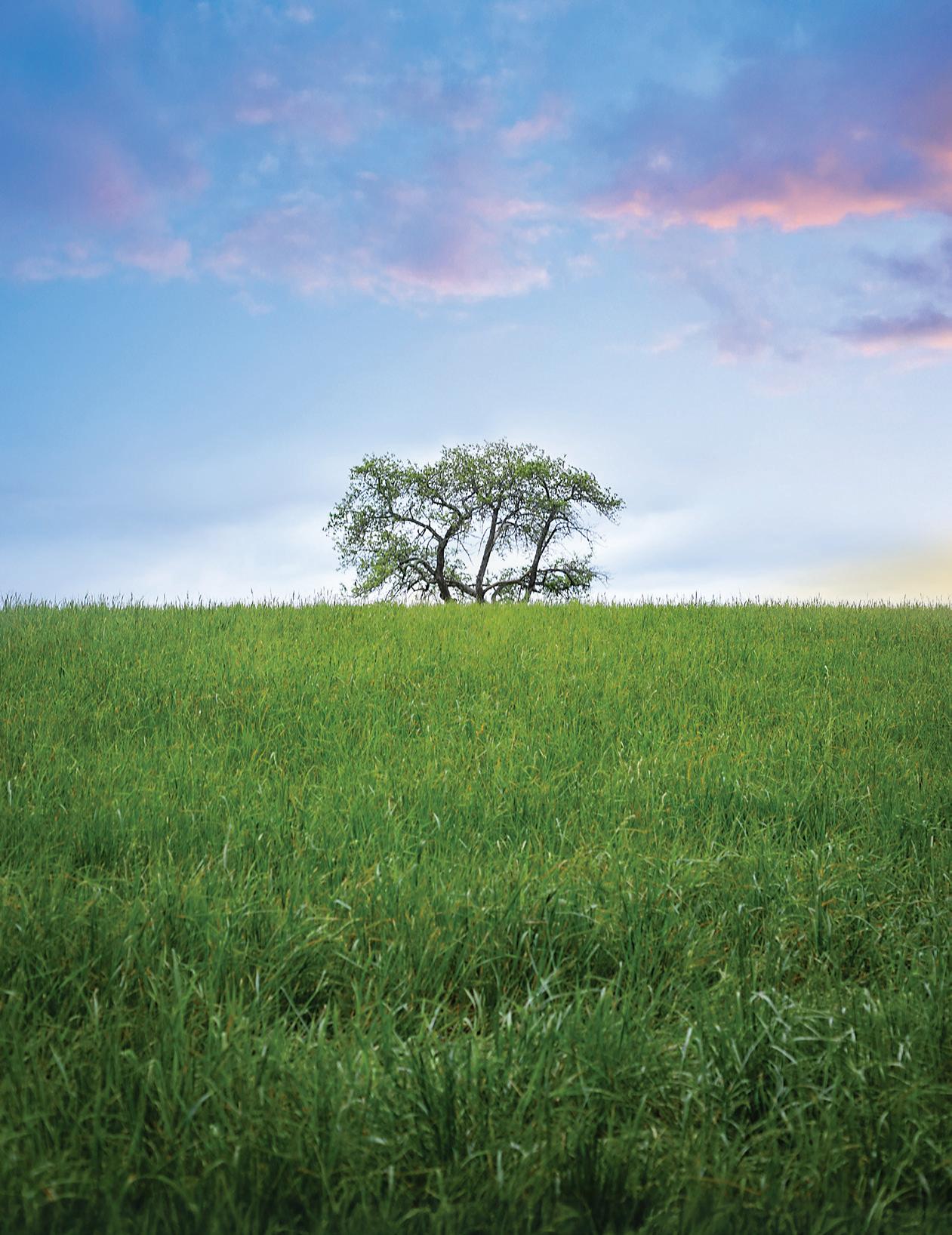
CHARTING A BOLD FUTURE
STORY AND PHOTOS BY RENÉE GANNON, TRUSTEES STAFF
TToday, our natural world faces urgent, growing threats from habitat loss, climate change, and human activity, which have the potential to significantly degrade the quality of life in our communities. As stewards of the land, we have a responsibility—and an opportunity—to rise to this occasion by increasing the amount of land we care for, inspiring even more people to get outside and join us in this work, and empowering our staff to increase their impact and capacity to drive our mission forward.
We’re charting a bold future for The Trustees—and for nature across Massachusetts.
FOR EVERYONE, FOREVER
For Everyone, Forever, The Trustees’ new five-year strategic plan, outlines the organization’s commitment to save, steward, and share the special places of
Massachusetts so they can be enjoyed for generations to come.
For Katie Theoharides, President & CEO of The Trustees, and Tom French, Chair of the Trustees Board of Directors, advancing the goals articulated in For Everyone, Forever is a collaborative effort. We caught up with them at Charles W. Ward Reservation in Andover to hear their thoughts on how the plan will move the organization forward.
TOM: We talk a lot about special places— Ward Reservation is particularly special to me. I grew up a mile from here. Our family would hike here, go cross-country skiing, and have picnics up on the hilltop. I feel transported when I’m here.
I’m also inspired by the story behind this place. The Kimball family owned and stewarded this land for generations. They painstakingly assembled it parcel by parcel and gifted all of it to The Trustees. It’s an amazing land conservation story that’s emblematic of what we do and how people support us.
KATIE: I love that story. Being here today also makes me think about how excited I am about the work we’ve done over the last year with our board, staff, and volunteers to accelerate our mission and impact going forward.
It’s amazing to think that The Trustees has been protecting these beautiful, scenic, historic, and cultural resources across the state for more than 130 years. And as Massachusetts' largest and the nation’s first conservation and preservation nonprofit, now is the perfect moment to lean into our core mission and do what we've always done really well—connecting people to landscapes and bringing them into the work of conserving special places for everyone, forever.
TOM: I couldn't agree more. Another thing I love about the plan is how we approached the strategic planning process. We went back to our mission and said, “In these times, what does our mission mean?

“In these times, what does our mission mean?
What does it call us to do?”
Chair of the Trustees Board of Directors, Tom French, takes Trustees President & CEO Katie Theoharides on one of his favorite hikes at Ward Reservation.

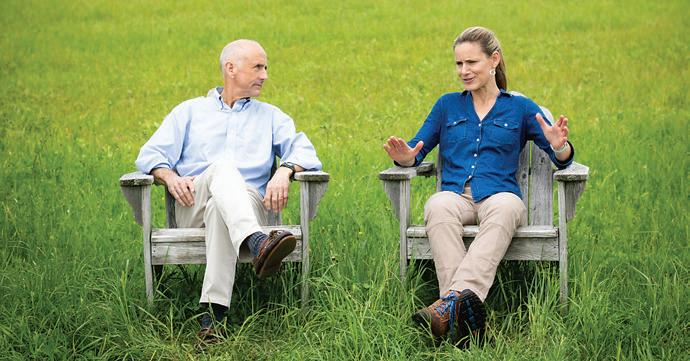
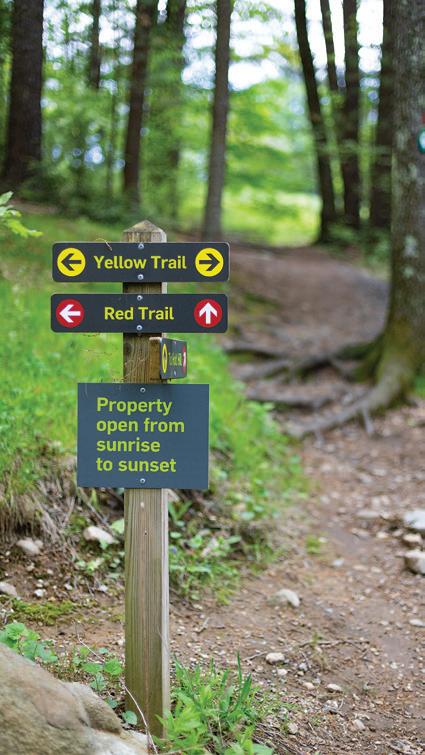
“It's an honor to protect these places for everyone...”
What does it call us to do?” We have this wonderful balance of looking back to our origin story, our roots, and our core mission—honoring and recommitting to our values, while at the same time bringing them to bear on the challenges and the needs of our time.
KATIE: The Trustees was founded in response to industrial sprawl, at a time when people were losing their connection to nature. We’ve reached another critical moment, as we continue to lose 13.5 acres of habitat to development in Massachusetts every day. The impacts of climate change are also becoming real—from coastal flooding and storm damage to forest fires occurring where we haven’t seen them in the past. And at the same time, we’re seeing people—especially young people— becoming more disconnected from nature.
TOM: Those challenges were top of mind as we formulated the plan. It’s why we’re tripling down on our commitment to drive land conservation across the Commonwealth—not only to preserve viewscapes and watersheds and habitat corridors in
perpetuity, but also to sequester carbon, which plays an essential role in fighting climate change.
It’s also critical that we foster those connections to nature that you mentioned. All of us come to this work for different reasons. For me, it’s about the borderline spiritual experience I have when I’m in a special place like this. That experience grounds me, fulfills me, gives me joy, and connects me with something deeply meaningful.
KATIE: That connection is so important. That’s why it’s great to see people on our properties discovering nature in the way you and I did as kids. For me, it started when I was growing up in Western Massachusetts surrounded by farms and forests. I spent all of my free time outside getting into some type of mischief—building dams in the streams and just feeling part of the natural world. My 10-year-old self would not believe the work I get to do here at The Trustees. It’s an honor to protect these special places for everyone, so that more people can connect with nature in the way we both have been so lucky to do.
WHERE YOU COME IN
Join us in this vital adventure to protect our one and only home. The Commonwealth is full of landscapes and places that give us so much: Beautiful vistas and beaches where we can reflect and refresh ourselves. Woodlands and waterways that provide clean air and drinking water. Grasslands and marshes that sequester carbon and nurture wildlife.
With this new strategic plan, The Trustees has shaped an ambitious vision for conserving, restoring, and sharing more of these beloved places with even more Members and visitors. Together, we will preserve the natural wonders of Massachusetts—for everyone, forever. More information about the strategic plan will be available on our website TheTrustees.org later this summer.
Ed. Note: The Trustees is grateful to Libretto for their assistance in developing the new strategic plan, and for their support of this interview.
The wide diversity of ecological habitats at Ward Reservation make it a very special place. Explore this sprawling landscape along almost 15 miles of trails and climb its three hills for great views of the Merrimack Valley all the way to the Boston skyline.
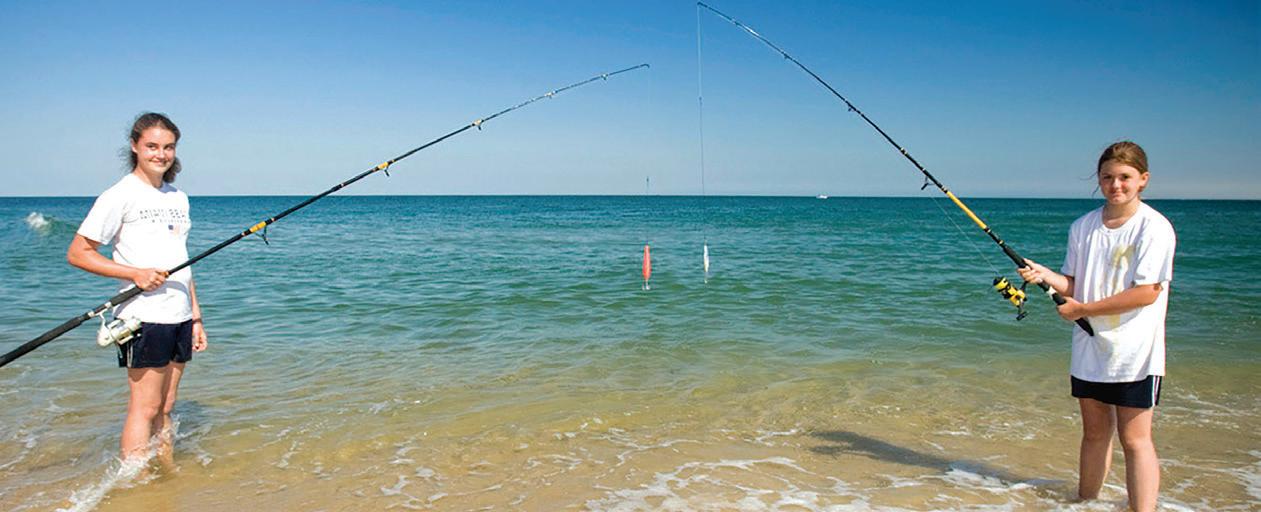
Going Chappy Happy
Chappaquiddick Island boasts three Trustees gems
Nestled off the east coast of Martha’s Vineyard is the small but well-known island of Chappaquiddick. After a fiveminute ferry ride across Edgartown Harbor, find yourself within minutes of three beloved Trustees’ properties on “Chappy”: Mytoi, Cape Poge Wildlife Refuge, and Wasque Reservation.
Mytoi
Mytoi is a 14-acre contemplative Japaneseinspired stroll garden in Chappaquiddick’s sandy pine woodlands, standing in rich contrast to the island’s barrier beaches, salt marshes, and coastal woodlands.
Between 1958 and 1966, Hugh Jones developed the stroll garden to encourage a moment for pausing, reflection, and appreciation of the beauty and highly trained scenery of the Japanese tradition. Almost completely erased by the fierce winds of Hurricane Bob in 1991, the garden re-emerged guided by a master plan from landscape architect Julie Moir Messervey and two passionate volunteer gardeners.
Today the garden celebrates the rich Japanese gardening traditions of age, renewal, and rebirth. Sand, stone, and duckboard paths wind through Japanese maples, pines, and flowering shrubs carefully trained to articulate the views within the garden. Boundary plantings and edge screening create intimacy and privacy, turning away from the broader scenery of sand and shore that dominate the rest of the island.
Cape Poge Wildlife Refuge
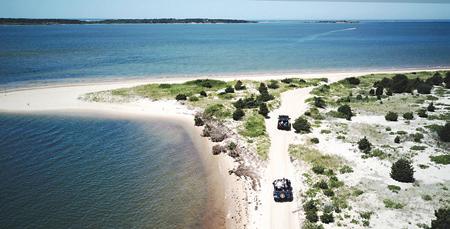
Cape Poge is well-loved for the Over-Sand Vehicle Access it provides to the easternmost beaches of Martha’s Vineyard. Formed thousands of years ago by offshore currents, the barrier beach on Chappaquiddick Island’s eastern edge extends for eight miles from Wasque Point past the Cape Poge Lighthouse to an area known as the Gut. Powerful currents push through and flush Cape Poge Bay with oxygen-rich water that attracts striped bass, bluefish, bonito, and albacore, while tidal waters support extensive salt marshes around Poucha Pond.
Cape Poge elbow is home to a gull rookery and nests of piping plovers, least terns, and oystercatchers, while the area known as The Cedars offers a glimpse of century-old, low-growing eastern red cedars sculpted by salt spray and wind.
At the northernmost tip of the sand barrier stands the Cape Poge Lighthouse.
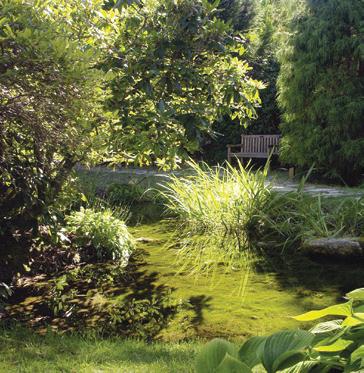
First erected in 1801, the lighthouse helped guide ships through the shoalwaters and shallows of Muskeget Channel, and into Edgartown Harbor. Storms and erosion felled the beacon twice; the lighthouse was rebuilt in 1844 and again in 1893 and this latter incarnation still stands and is today maintained by the U.S. Coast Guard.
Wasque Reservation
Wasque (pronounced “WAY-skwee”) is a land of shifting sands and changing ecology, where sea level rise, ever-fiercer storms, and strong long-shore currents demonstrate their impacts all along the coastline. A popular saltwater fishing destination, Wasque is in transition due to these destructive forces— no longer featuring the sweeping white sand beaches that many Vineyarders remember from long ago.
The reservation’s dry, acidic, sandy soil nurtures an oak and pine forest, rare sandplain grasslands, and heathlands. Windy conditions, grazing, and fires have kept forests from taking hold here. It’s a place in a constant state of flux, where no two visits are ever quite the same.
Leland Beach, also known as East Beach, links Wasque and the Cape Poge. The Trustees manages the 100+ acres and half mile of beachfront for the Division of Marine Fisheries (DMF), which has owned the property since 1993. Fishing access is preserved through this collaboration, allowing access to the legendary Wasque Point surf-fishing waters.
PHOTO BY JIMMY PENNA; COURTESY OF VINEYARD VINES
© TRUSTEES
TRUSTEES PEOPLE

FBETTER than EVER!
Trustees Members engineer improvements to the inner workings of Castle Hill
or nearly ten years, Mike and Ellen Garvey have collaborated closely with staff at Castle Hill on the Crane Estate in Ipswich—especially Curator Susan Hill Dolan—to rehabilitate the nearly 100-yearold master clock and wind-indicator system at the Great House. We sat down with Mike and Ellen to highlight their work and experience as long-time Members of and volunteers with The Trustees.
Q: How long have you been Members of The Trustees?
A: We have been Members for about 10 years.
Q: Why did you choose to become Members?
A: We like to support the mission of The Trustees in preserving the treasures in our area and bringing events to the public in these wonderful spaces.
Q: What makes The Trustees special to you?
A: The Trustees is a unique organization; the people we have worked with are all very professional. They are supportive and
appreciative of the work of their many volunteers and go out of their way to make our contributions effective.
Q: Tell us about the work you have been doing at Castle Hill.
A: We restored the Gallery clock in the Great House in 2017. It has been operating without interruption since then.
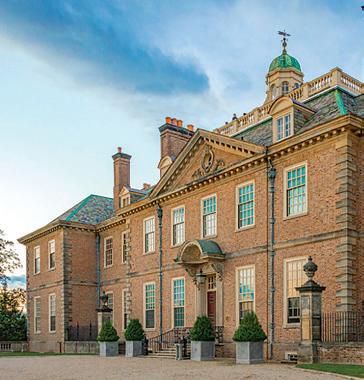
BY MEAGHAN FLAHERTY, TRUSTEES STAFF
The Wind Indicator project began with an investigative phase in March of 2018. A key decision came from our sponsor, Susan Hill Dolan, who said, “The Cranes used the latest technology of their day. We should do the same, while preserving the appearance and functionality of the original system.” The system concept using a modern weather station was presented in January 2020, when work began in earnest.
We had almost no documentation, neither for how the system worked nor for its implementation in the Great House. Nevertheless, we continued to map out the wiring system in the House. Key elements were clearly missing. A pivotal event was our March 2022 visit to the Trustees
Archives & Research Center in Sharon, MA. We found original drawings of the Great House which identified locations of critical wiring, allowing us to restore the functionality of the system. In May that year, we were able to demonstrate functionality of the full system.
The final system employs the original Gallery “motor” [sic] and original wiring with a modern weather station, a Raspberry
PHOTO BY STONEY STONE
Pi controller and solid-state switches to control the wind indicators. Original incandescent lamps were replaced with LEDs to lower the operating voltage from 110 to 6 volts.
Q: What is next for your project at Castle Hill?
A: The Wind Indicator system was completed in 2022 and, except for battery replacement in the outdoor weather station, little maintenance is anticipated. We are looking next at restoring some part of the Great House Annunciator system, specifically the call box which indicates which room requires assistance.
Q: Is there anything else you would like to share?
A: Our restoration projects at Castle Hill would not have been possible without the ongoing enthusiastic collaboration of Curator Susan Hill Dolan. Susan facilitated our visits to the Great House and ensured that we had access to all the resources we needed to execute the work.
On a personal note, we live in a circa 1900 shingle style home in Swampscott, in the Olmsted Historic District. We acquired the house in 1979 when we moved to New England and have worked to carefully preserve the original architectural features of our home. These efforts were recognized in 2014 with the Swampscott Historic Commission Preservation Award.
iThe Garveys’ volunteer work at the Great House is grounded in their career experiences. Mike’s professional career was as a scientist designing atomic clocks at a company in Beverly. Ellen worked as a software engineer in high tech and retired from Cisco. For the Wind Indicator project, Mike designed and implemented the electronics, and Ellen designed and implemented the software to control the system.
Never the ones to slow down, when Mike retired, he returned to a former avocation as a beekeeper, achieving certification as a Master Beekeeper (Cornell Univ) in 2019, and Ellen started blowing glass and now also creates fused glass as well. Rounding it all out, both are avid cooks and gardeners.
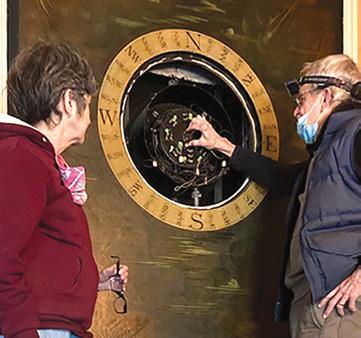


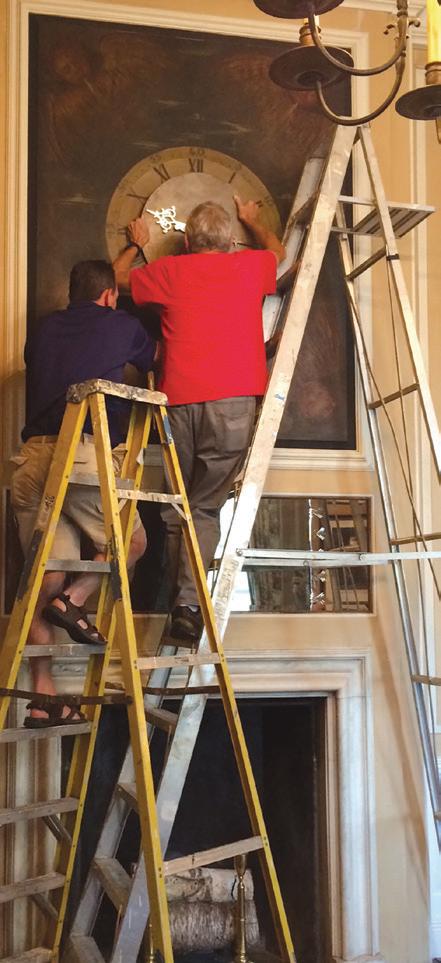
"We are looking next at restoring some part of the Great House Annunciator system, [left,] specifically the call box which indicates which room requires assistance."

Connecting the Circuit
Discover Trustees places on the Bay Circuit Trail
BY MEAGHAN FLAHERTY, TRUSTEES STAFF
Beginning at Plum Island in Newburyport and ending at Kingston Bay in Duxbury, the Bay Circuit Trail encompasses more than 230 miles of trails open to hiking, biking, snowshoeing, and more. "The Bay Circuit Trail (BCT) is more than just a path; it's a living ribbon weaving through 38 diverse towns and cities, and connecting the vibrant tapestry of eastern Massachusetts,” notes Sarah Dolan, Bay Circuit Trail Outreach Assistant. “It's like an 'outer Emerald Necklace' for the Boston metropolitan area, linking communities from the North to the South Shores.”
The BCT is easily accessible to public transportation via the T and commuter rail. “What's truly remarkable is its varied nature—a dynamic mix of dedicated unpaved trails, scenic bike paths, and necessary road connections that allow it to seamlessly thread through serene forests, historic farmlands, and surprising urban green spaces. It offers close-to-home nature experiences right in people's backyards, even for those in more developed areas,” continues Dolan. “It's a testament to conservation, community, and the simple joy of lacing up your boots to explore the natural world that's closer than you think."
With options for walking, biking, snowshoeing, horseback riding, and crosscountry skiing, you can find something for every season on the Bay Circuit, as well as at these Trustees properties that connect with it.
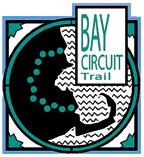
TRUSTEES INTERSECTIONS
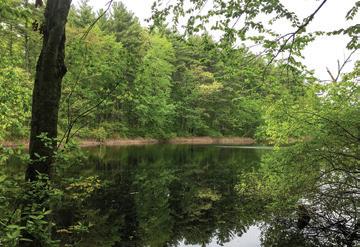
Pint-sized Shattuck Reservation, in Medfield, is comprised of an oak and pine forest overlooking a wet meadow and red maple swamp. Not only does Shattuck link with the BCT, but the reservation is part of a network of Trustees properties by the Charles River, forming a paddling trail in the summer.
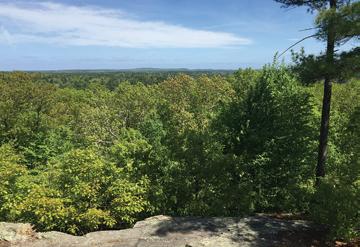
Look for a trail extension across Causeway Street to connect from Shattuck Reservation to Noon Hill. Noon Hill rises gently through a trail and ridge dotted with pine, beech, birch, and hemlock. Stop for a snack and a view of Holt Pond, created in 1764 when the nearby Sawmill Brook was dammed to create a mill pond.
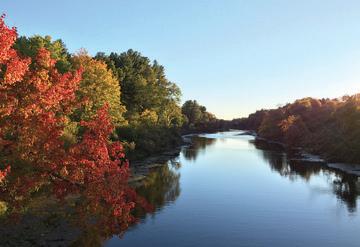
Known as the “Gates of the Charles,” Rocky Narrows in Sherborn became The Trustees’ first reservation in 1897. Traverse the extensive trail system, including the BCT and the Sherborn Town Forest. A canoe landing starts a two-mile loop trail to the Rocky Narrows Overlook, a stunning ledge with views of the namesake Narrows along the Charles River.
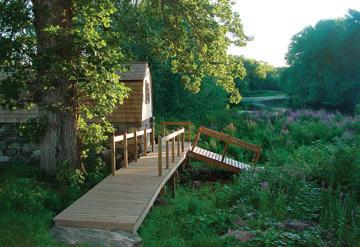
Moving North to Concord, find yourself at The Old Manse. Approach through Minute Man National Historical Park and spend some time exploring the grounds or taking a themed house tour highlighting the revolutionary and transcendental history of the space.
The Bay Circuit Trail crosses multiple Trustees places North of Boston, as well, including Ward Reservation in Andover, Appleton Farms & Grass Rides in Hamilton & Ipswich, and Old Town Hill in Newbury.
PHOTO BY TOM KATES
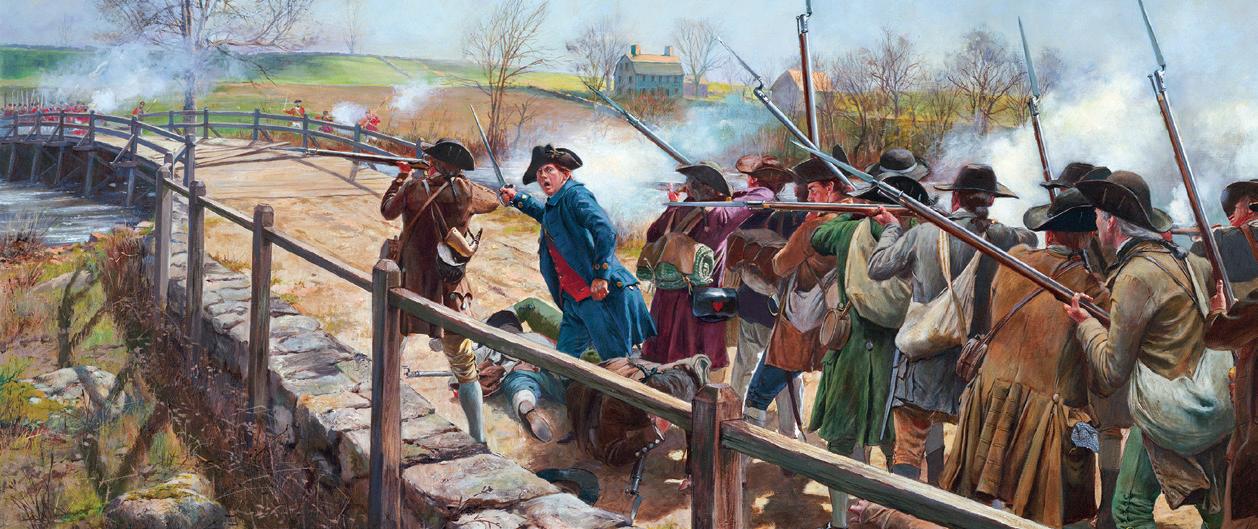
“This Morning between
1 & 2 O’clock
we were alarmed by the ringing of ye Bell.”
— The Old Manse, Concord, April 19, 1775; from the journal of Reverend William
Emerson
AmericAn independence at The
TrusTees
Inspiring places across the state are forever linked to the fight for freedom

The crack and boom of Minutemen and Redcoat muskets launched the struggle for independence from Great Britain right here in Massachusetts. Their sound—and cause—would resonate throughout the Thirteen Colonies, eventually leading to the founding of our nation. Yet these events would not have happened if not for revolutionary moments and key figures connected to locations now protected and cared for by The Trustees.
“This year marks the 250th anniversary of the start of the American Revolution, the first shots of which were fired only a few hundred yards from The Old Manse in Concord,” said Cindy Brockway, Trustees Senior Managing Director of Cultural Resources. “But that’s not the only Trustees site connected to esteemed figures, key Revolutionary War battles, or inspiring stories from this period. Our cultural sites are a three-dimensional textbook of Massachusetts history that spark the imagination and beckon exploration.”
From the western hills to the eastern shores—and many places in between— colonial homes, fields, farms, gorges, and hilltops played pivotal roles in both familiar watershed moments as well as events often left out of the national narrative. See a preview of the stories these landscapes tell in the map on the next page, or dive deeper into the connections by visiting TheTrustees.org/Independence
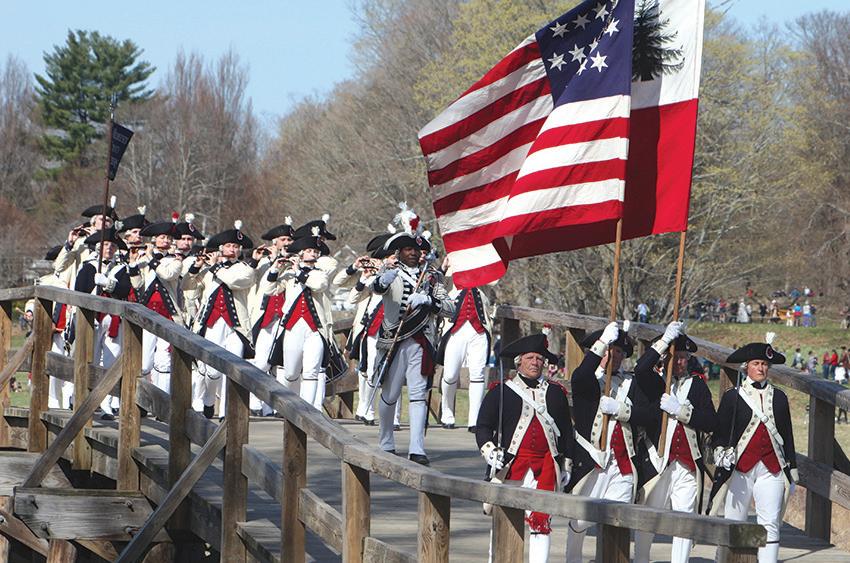
BY MATTHEW LUG
Did You Know?
Around a dozen Trustees locations operated as farms and mills during the Revolutionary War. Many sites have since been reclaimed by nature, but signs of the land’s previous use— low stone walls, foundation ruins—can still be seen today. Keep an eye out as you visit Trustees landscapes throughout the state, like Fork Factory Brook in Medfield and Bear’s Den in New Salem!
PHOTO
STATEWIDE MAP
The Mission House STOCKBRIDGE
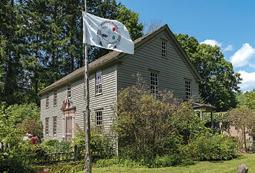
Only days after the first shots were fired in Concord, the Mohican men of Stockbridge answered the patriotic call to arms. They served as scouts and warriors at Bunker Hill, Bennington, Ticonderoga, Saratoga, and across the northeast. General George Washington honored their service by sponsoring an ox roast in Stockbridge in 1783. Before and during the war, Native community members—including these veterans—were stripped of their land rights, forcing many to move away from their homeland. Today, the Stockbridge-Munsee Band of Mohican Indians is telling their own story, in their own words, on their ancestral land through ongoing exhibitions at The Mission House.
Chesterfield Gorge CHESTERFIELD
6,000 British soldiers marched across this gorge along the old post road connecting Albany, New York to Boston after General John Burgoyne’s defeat at Saratoga in October 1777. The bridge used during their journey was swept away by floodwaters in 1835, but its stone abutments are still visible today.

The Colonel John Ashley House SHEFFIELD
The Old Manse CONCORD
6 5 4 3 2 1
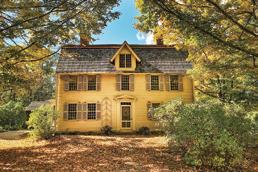
The first shots of the American Revolution rang out at the Old North Bridge on April 19, 1775, only a few hundred feet from this home. Owned by influential minister Reverend William Emerson and his wife Phebe Bliss, many sermons championing liberty and independence from Great Britain were penned within these walls. The Emerson and Bliss families also embodied a contradiction at the heart of the Revolution: the fight for freedom and the perpetuation of slavery. The lives of Cate,
Fruitlands Museum HARVARD
A precursor to the Declaration of Independence—the Sheffield Resolves— is believed to have been drafted in this home in 1773 with Col. Ashley moderating. He later financially backed the Continental Army while his son fought as a colonel with the 1st Berkshire Regiment. When Massachusetts ratified its new Constitution in 1780, Elizabeth Freeman—who was enslaved by the Ashleys—drew upon its revolutionary language to sue for her freedom, paving the way for the end of slavery throughout the state. Learn more about her life and legacy when visiting this historic home.

Shortly before the Revolutionary War, the Shakers arrived in America. The utopian religious group known for its devotion to pacifism was originally viewed with suspicion but slowly gathered followers drawn to the Shaker beliefs of communal living, and gender and racial equality. They established their second American settlement in Harvard and continued to form communities throughout the colonies. Soon after the Harvard Shaker Village closed in 1918, the historic Shaker Office was moved to the Fruitlands hillside where it was restored and opened to the public as the world’s first Shaker Museum. Here it remains to this day to share and celebrate Shaker beliefs and traditions.

Governor Hutchinson’s Field MILTON
The last royal Governor of the Massachusetts Bay Colony, Thomas Hutchinson built a country estate on these grounds in the mid-1700s. He was charged with upholding British rule in the restless colony, but in 1774, shortly after the Boston Tea Party, he fled to England. His property and effects were confiscated and later sold at auction. Stroll through the field to find a “ha-ha” (retaining wall and ditch used as a livestock barrier) which is the only visible remnant of this former estate, along with views of the Neponset River and Boston skyline.
Charles W. Ward Reservation ANDOVER
The focal point of this sprawling landscape is 420-foot-tall Holt Hill, the highest point in Essex County. On June 17, 1775, townspeople climbed to the top of the hill to watch the burning of Charlestown during the Battle of Bunker Hill. Visitors can hike to this same vantage point today for views of the Merrimack Valley and the Boston skyline.
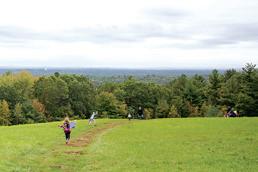
Appleton Farms HAMILTON & IPSWICH

Established in 1638 by one of the country’s founding families, this farm was split into two acreages operated separately by cousins Isaac and Oliver Appleton during the American Revolution. Their work included hauling hay, cutting thatch, sawing wood, and selling posts and rails. Wander the trails around this working farm—one of the oldest continually operating in America—and stop by the Farmhouse, which stood in this same spot through the war and now reflects generations of change and fascinating history.

Gerry Island MARBLEHEAD
Walk across at low tide or journey by watercraft to this island once owned by Thomas Gerry, whose son Elbridge Gerry grew up to be a signer of the Declaration of Independence, delegate to the 1787 Constitutional Convention (where he helped draft the Bill of Rights), Governor of the Commonwealth, and Vice President of the United States under President James Madison.

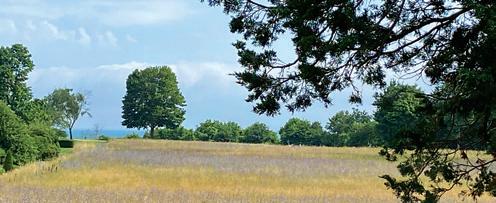

a “Muster Ground” by Plymouth farmers in the militia to assemble and train colonial Minutemen companies in the lead-up to the Revolutionary War.
We love seeing your photos and videos of Trustees special places! Share them on your favorite social media platform, add #TheTrustees to your post so we see them, and we will select our favorite images to share in this gallery.
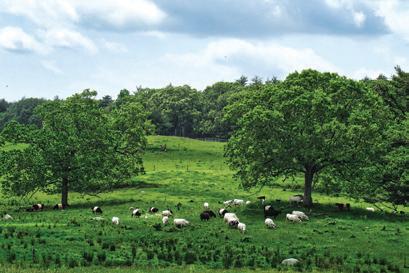



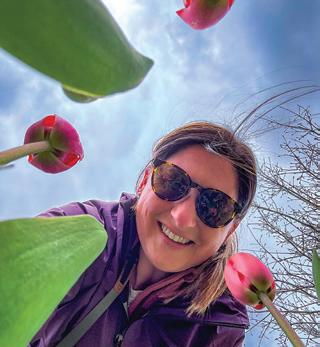
Many of your favorite properties are also on social media. To find out the details, visit their pages on the Trustees website, at TheTrustees.org
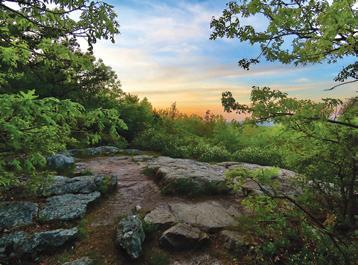
|
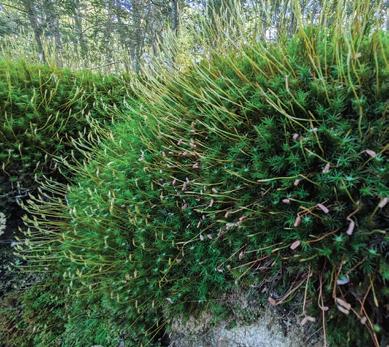
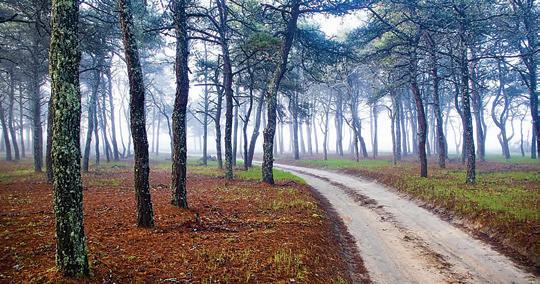
Follow The Trustees on these social media platforms:
FACEBOOK: Facebook.com/TheTrustees
INSTAGRAM, TIKTOK, X: @TheTrustees
PINTEREST: Pinterest.com/TheTrustees
LINKEDIN: The Trustees of Reservations
#TheTrustees
The photos in this gallery were sourced from Trustees followers on Instagram and Facebook, including the Trustees Hikers group on Facebook. Thank you for sharing your images with us! Left to right, top to bottom, the reservations and photographers are: Appleton Farms (Hamilton & Ipswich), Scott Hufford; Brooks Woodland Preserve (Petersham), Shawn Adams; Copicut Woods (Fall River), @deepdarkwoodscleanup; Naumkeag (Stockbridge), @newenglandchickadee; Rocky Narrows (Sherborn), @dwicefox; Powisset Farm (Dover), @demosskipitaris; Wasque (Chappaquiddick Island), @joncohanphotography; Peaked Mountain (Monson), Lee Ann Gale.
A green gift of Trustees
Membership is perfect for any occasion: graduations, weddings, family reunions, co-worker appreciations, holidays, and many more!
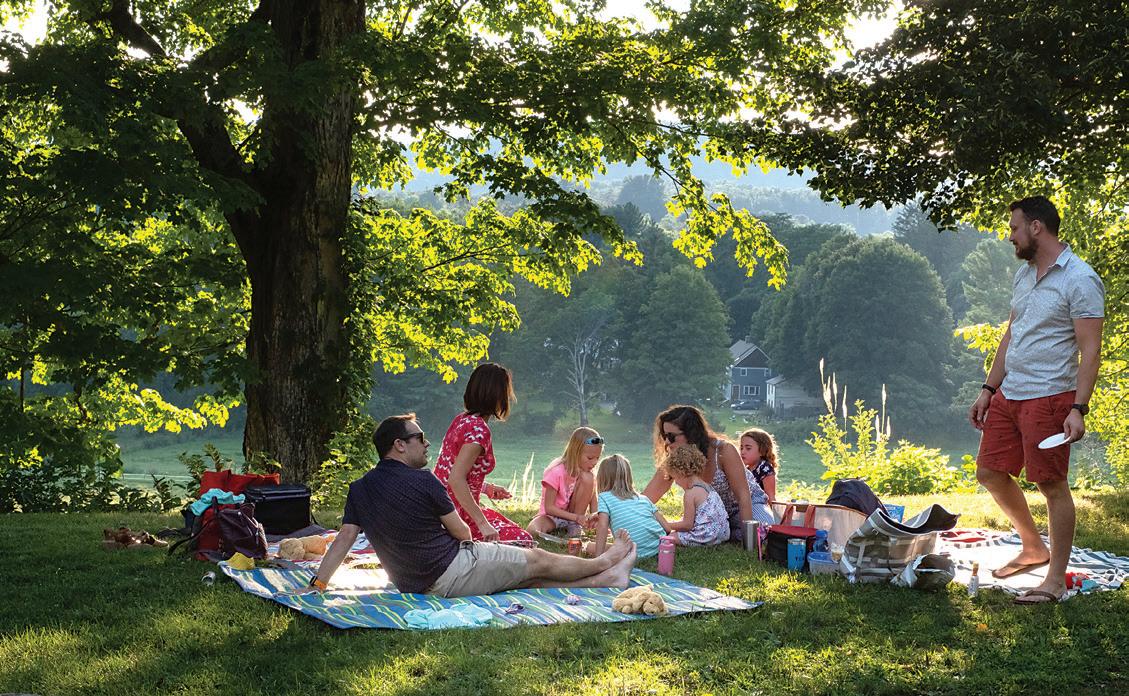
For information and to purchase, visit
The Trustees is Massachusetts’ largest, and the nation’s first, conservation and preservation nonprofit. We are supported by members, friends, and donors. Explore more than 120 amazing places across Massachusetts, from beaches, farms and woodlands, to historic homes, museums, urban gardens, and more.
Katie Theoharides President & CEO
Nathan Hutto Chief Operating Officer
Gerben Scherpbier Chief of Staff & Senior Advisor to the President & CEO
Janetta Stringfellow Chief Development Officer
Brian Therrien Chief Financial Officer
Janelle Woods-McNish Chief Marketing & Diversity Officer
EDITORIAL
Wayne Wilkins Director, Brand & Content Editor
Sarah Cassell Managing Director Marketing & Communications
Chris Costello
Gina Janovitz Senior Graphic Designers
We invite your input, letters, and suggestions. Please send them to:
Special Places | The Trustees 200 High Street, 4th Floor Boston, MA 02110 tel 978.921.1944 email Marketing@TheTrustees.org
For information about becoming a Member please contact us at 978.921.1944, email us at Membership@TheTrustees.org, or visit our website at TheTrustees.org.
If you need to find your Member code, account information, or look up ticket and registration status for specific programs, visit TheTrustees.org/CustomerService
Special Places, Summer 2025.
Volume 33, Issue Number 2. Special Places (ISSN 1087-5026) is published quarterly and distributed to members and donors of The Trustees of Reservations.
Copyright © 2025. All rights reserved. Photographers may retain copyrights.
Printed in the USA by Cummings Printing, which recycles material used in manufacturing, adheres to strict environmental standards, and uses soy and vegetable based inks.
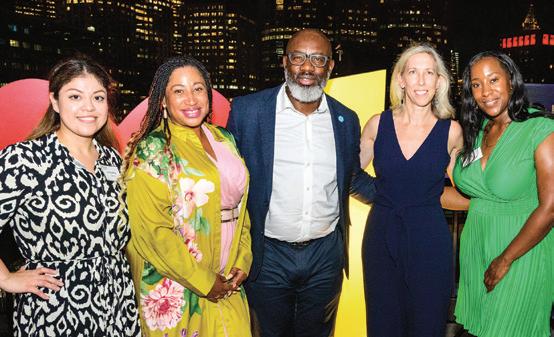
Make a difference this year…
Founders Circle members are vital partners who ensure The Trustees continues to thrive. Join and receive special invitations, private tours, and more!
We count on your generous support to make our work possible. TheTrustees.org/FoundersCircle
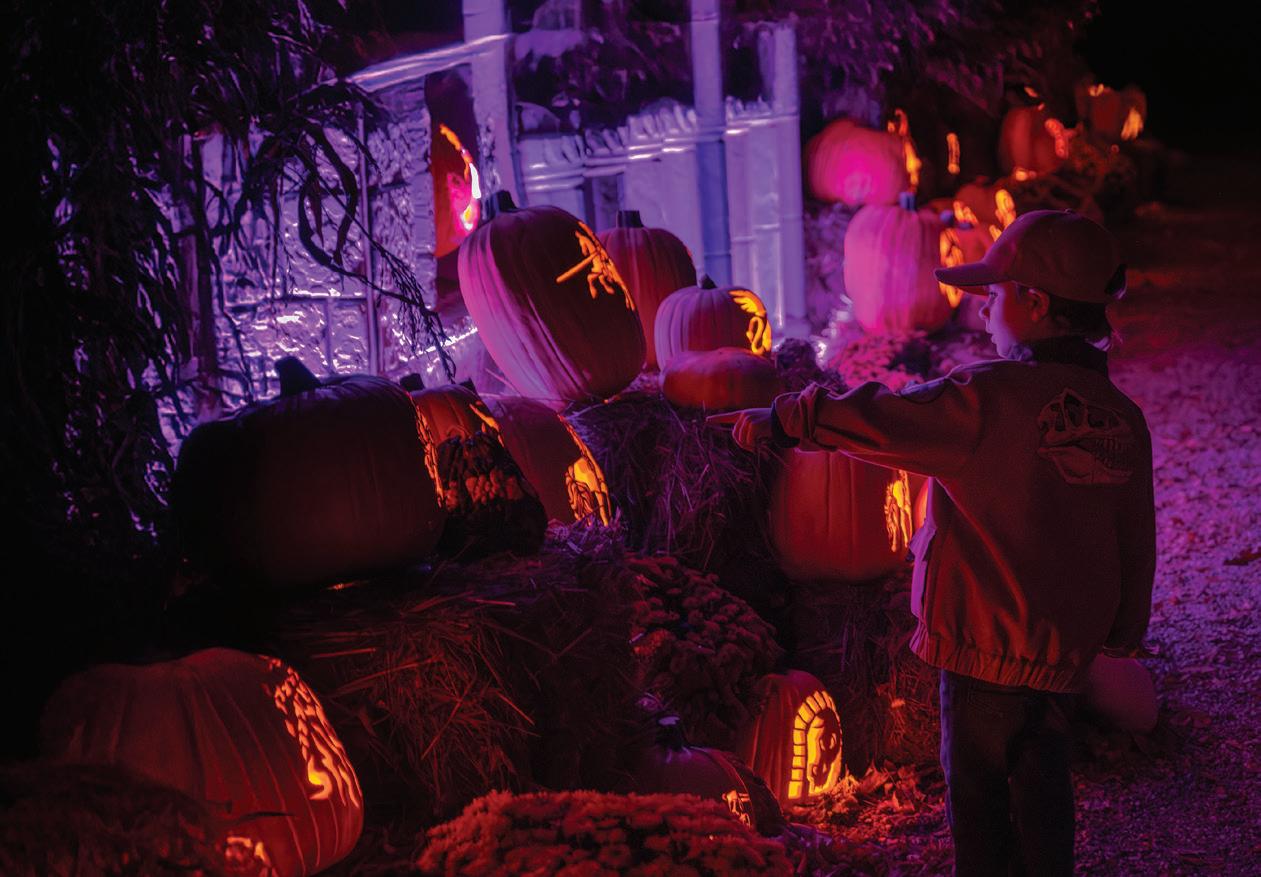
THE INCREDIBLE NAUMKEAG PUMPKIN SHOW
WEDNESDAYS-SUNDAYS, OCTOBER 1–31
In the Berkshires at Naumkeag, Stockbridge
HALLOWEEN ON THE HILL
WEDNESDAYS-SUNDAYS, OCTOBER 3–30
(PLUS MONDAY & TUESDAY, OCT 27 & 28)
North of Boston at Long Hill, Beverly
SAVE THE DATE!
MEMBER TICKETS GO ON SALE THURSDAY, SEP 4
Ticket sales for the general public open Wednesday, Sep 10
